Saving Western civilization one student at a time.
Summer 2023

Saving Western civilization one student at a time.
Summer 2023
 by Tom Sculthorpe
by Tom Sculthorpe
Lightning & Other Uncertainties
Raising Human Beings in a STEM World
by Martin CothranLibraries and Laboratories
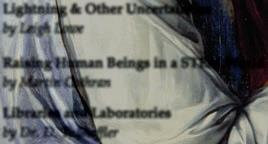 by Dr. D. T. Sheffler
by Dr. D. T. Sheffler
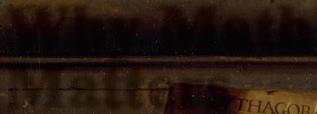
In1704, Jonathan Swift wrote a tongue-in-cheek story about the battle between ancient and modern books— between the proponents of a broad education that includes literature and history on one side, and the proponents of what would be the equivalent today of an education focusing on science and math and engineering and technology.
The quarrel begins on Mt. Parnassus, which has two hills on its crest. The highest hill is occupied by the Ancients and the lower by the Moderns, who, dissatisfied by their lower station, complain that the Ancients' higher station is ruining their view. The Moderns offer the Ancients a choice: remove themselves and their effects down to the lower mount so the Moderns can take the high ground or allow the Moderns to take picks and shovels and lower the height of the Ancients' hill.
Understandably, the Ancients are not keen on either idea. They point out that the only reason the Moderns have a place on Parnassus at all is because the Ancients allowed them to settle there. The Ancients tell the Moderns that trying to level the two hills is folly since the hills are made of rock and the process would "break their tools and their hearts" without any damage to the hill.
Instead, the Ancients tell the Moderns they should raise their own side of the hill to a comparable height, an effort the Ancients would not only allow but aid. But the Moderns refuse this generous offer and choose instead to try and wrest the higher hill from the Ancients, resulting in a war between the two. Swift portrays this war as waged by books in a library, with ink as the chosen weapon. The Moderns deploy Tasso and Milton and Dryden, Hobbes and Descartes; the Ancients send forth Homer, Pindar, Euclid, Plato, Aristotle, Herodotus, and Livy. Swift's sympathies are clearly with the Ancients, who are tolerant and broad-minded, as opposed to the Moderns who are arrogant, divisive, and overly critical.
If you visit the Bodleian Library at Oxford today, you will see that the great old volumes are fixed to the bookshelves with chains. You will be told that this is so no one can take the books, but Swift maintains that books are secured by chains of iron because otherwise they might, on account of their restless and disorderly spirits, fight with one another.
Swift's parable is about the centuries-long battle between the advocates of method, technology, and innovation, who consider their disciplines to be so-called "hard" sciences, and what they consider to be the "softer" sciences of history and literature. But what they fail to acknowledge is that their own disciplines of math and science were birthed out of philosophy itself, and were once a part of the larger and more balanced project of classical education.
Still today we are tempted to pit subjects such as math against what we call the liberal arts, unconscious of the fact that arithmetic and geometry have always been considered liberal arts. In fact, of the seven traditional liberal arts, four were mathematical. The very word "science" is now used exclusively to refer to the natural sciences, which contradicts the older, classical use of the word as referring to all bodies of organized knowledge. In a complete and balanced education there is no squabbling between the natural sciences and what we now call the humanities, but a harmony between them, since they are both directed at the truth.
The Moderns have always wanted a divorce, but the Ancients still want to save the marriage.
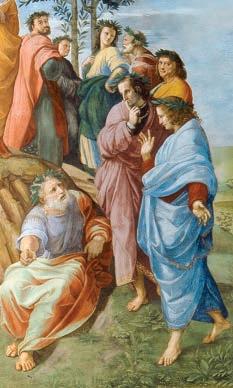
2 Letter from the Editor by Martin Cothran
12 Libraries and Laboratories by Dr. D. T. Sheffler
20 Lightning & Other Uncertainties by Leigh Lowe
24 Mastering Math by Cheryl Lowe
34 From Plato to Christ by Louis Markos
58 Raising Human Beings in a STEM World by Martin Cothran
68 Where Mathematics, Science, and Art Converge by Dr. Carol Reynolds
76 Math, Music, & Memory by Cheryl Swope
80 Why Math Matters by Tom Sculthorpe
88 The Language of Mathematics by Brian Lowe


 by Leigh Lowe | Grades 1-4
by Leigh Lowe | Grades 1-4
Prima Latina is a gentle introduction to Latin specifically designed for students and teachers with no Latin background. It teaches the basic parts of speech while introducing Latin, grounding students in the fundamental concepts of English grammar. Each lesson includes five Latin vocabulary words and English derivatives, a Latin saying, a Latin prayer, and grammar exercises. If you are looking for additional support in teaching your student, the author, Leigh Lowe, has recorded detailed Instructional Videos for every lesson that are sure to delight your young students! Prima Latina transitions seamlessly into Latina Christiana


$107.01 complete set (student, teacher, CD, videos, flashcards)
$40.14 basic set (student, teacher, CD)
Student $17.35 | Teacher $17.35 | CD $10.00

Videos $55.00 | Flashcards $16.75
Grades 1-4
Student Workbook $11.50 | Teacher Key $6.00 Help students make connections between the Latin grammar they are learning in Prima Latina and English grammar with these single-page worksheets. We highly recommend this companion book, which can also be used as a standalone review of English grammar to solidify concepts already learned if your student is not doing Prima



 by Cheryl Lowe | Grades 3-6
by Cheryl Lowe | Grades 3-6
Begin your Latin study here or continue on from Prima Latina . Each lesson consists of a grammar form, ten vocabulary words, English derivatives to help build vocabulary, and a Latin saying that teaches students about their Christian and classical heritage. The Teacher Manual includes a complete copy of the student book with overlaid answers, and provides detailed weekly lesson plans, comprehensive teaching instructions, tests, and weekly quizzes and keys.
$105.01 complete set (student, teacher, CD, videos, flashcards)
$47.07 basic set (student, teacher, CD)
Student $18.40 | Teacher $21.95 | CD $10.00
Videos $55.00 | Flashcards $16.75

Grades 3-6
Review Worksheets $11.50
Review Worksheets Key $6.00
We highly recommend Latina Christiana Review Worksheets as a companion to Latina Christiana. Two pages of cumulative review for every lesson of Latina Christiana will ensure your students get weekly reinforcement of old and new concepts.




Grades 3-6
Games & Puzzles $13.60 | Games & Puzzles Answer Key $6.00

In this activity book we've stuffed enrichment activities of every kind to help your students practice the vocabulary, grammar, and derivatives in Latina Christiana . Students will find hours of enjoyment playing Latin hangman, solving Latin crossword puzzles, and competing against each other in Latin picture games, while you can secretly delight in the fact that such "fun" work is actually worthwhile!
Wall Charts (left) (33" x 17") (4 charts total) $22.00

Desk Charts (right) (8.5" x 11") (4 charts total) $14.65


All of the grammar forms from Latina Christiana are organized here in a clean, easy-to-read format that is a perfect visual aid for a classroom wall or student desk.



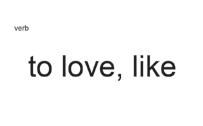
The Latin Forms Series is based on decades of teaching experience and use in private schools and homeschools around the world. First Form is the ideal text for all beginners, grades 5 and up, or is a great follow-up to Latina Christiana. The uniqueness of the Forms Series lies in two features:




1) A systematic, grammar-first approach to learning Latin that is suitable for the grammar stage student—and all beginners, regardless of age, are in the grammar stage of learning.
2) Extensive workbook exercises that ensure skill mastery and rapid recognition of inflected forms.
Our text and guides help every student (and teacher!) make sense of this difficult subject. A complete set includes:
• 34 two-page lessons in the Student Text are paired with 4-6 pages of Student Workbook exercises, weekly Quizzes, and unit Tests to make sure your students are mastering and retaining what they learn.
• The Pronunciation CD and Flashcards provide constant practice of grammar forms and vocabulary.
• The scripted Teacher Manual and complete Teacher Key give even the most novice Latin teacher the tools to teach with confidence.
• Instructional Videos in DVD or streaming format are also available, to bring the experience and expertise of a Highlands Latin School master teacher into your home.

(First Form shown)
$136.16 complete set ea. (all 5 books, CD, videos, flashcards)
$75.01 basic set ea.
(all 5 books + CD)
Text $15.75 ea. | Workbook $17.35 ea. Teacher Manual $13.60 ea. | Teacher Key $17.35 ea.
Quizzes & Tests $6.00 ea. | CD $10.00 ea. | Flashcards $16.75 ea.
Instructional Videos: DVDs or Streaming $55.00 ea.

First Form Latin: Latin Grammar, Year One
by Cheryl LoweGrades 5+ (Grades 4+ if completed Latina Christiana)
Second Form Latin: Latin Grammar, Year Two
 by Cheryl Lowe | Grades
by Cheryl Lowe | Grades
6+
Third Form Latin: Latin Grammar, Year Three by Cheryl Lowe | Grades 7+

First & Second Form Latin Review Summer Review Courses
 by Cheryl Lowe
by Cheryl Lowe
Grades 5+
Student $14.65 ea. Key $11.50 ea.
Fourth Form Latin: Latin Grammar, Year Four by Cheryl Lowe & Michael Simpson Grades 8+







Students are prone to forget what they have learned from year to year—an especially detrimental loss for the Latin student. To prevent this, Memoria Press has developed these summer courses that feature vocabulary review, form drills, and other exercises, all designed to foster mastery and retention.



New American Cursive font
Grades 1-4
$16.30
This Latin copybook in the New American Cursive font, featuring vocabulary practice and a page to copy each prayer in Prima Latina, is a great way to help your children practice their Latin while developing penmanship skills.
Hymns & Prayers
Grades 4-6
$16.30
Practice your cursive with Latin sayings and hymns and prayers from Latina Christiana, First Form Latin, and Lingua Angelica
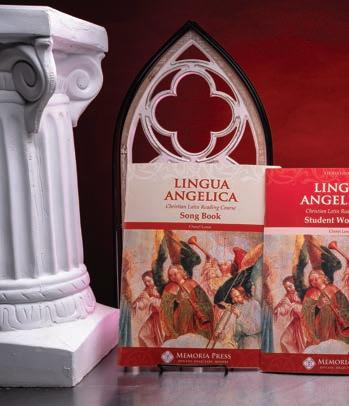
Grades 4+ | $28.25 set (flashcards and handbook)
Flashcards for every grammar form taught and recited in our Latin Forms Series and a handbook with a lesson-by-lesson schedule for coordinating with the recitations in First Form through Fourth Form


Grades 3+
CD & DVD
$17.35
The entire Latin grammar, presented by Cheryl Lowe. CD is audio only; DVD includes visual grammar charts.
Memoria Press Guides to the National Latin Exam by Cheryl Lowe, Susan Strickland, and Jon Christianson
Grades 5+
Introduction $11.50
Beginning Latin Exam (formerly Level I) $17.35


Intermediate Latin Exam (formerly Level II) $21.95


Intermediate Reading Comprehension Exam (formerly Level III) $21.95
These guides include the vocabulary, grammar, syntax, Roman history, culture, mythology, and geography commonly found on the National Latin Exam. When paired with previous exams, these guides are perfect preparation for the NLE.
Find samples and full product descriptions at MemoriaPress.com!

Latin & Greek Roots for Beginners by Paul O'Brien

Grades 6-8
$23.05
An introduction to English vocabulary through a study of Latin and Greek roots.



Advanced Vocabulary Building from Latin Roots by Paul O'Brien


Grades 8+
Student $26.20
Key $6.00
Your student will learn the definition and etymology of over 1,500 English derivatives, along with prefixes, suffixes, and supplemental Latin vocabulary lists.



Old Testament Stories in Latin by Martin Cothran

Grades 9+
Student $21.95
Teacher $21.95
Wall Charts (33" x 17")
First Form (4 charts) $22.00
Second Form (3 charts) $22.00

Latin Songs & Prayers (Translation Course)
by Cheryl Lowe
$45.68 set ea. (student & teacher, song book, & CD)
Student $13.60 ea. | Teacher $19.45 ea.
Song Book* $11.50 | Music CD* $12.55
*Used for both LA I and II
Desk Charts (8.5" x 11")
First & Second Form (6 charts) $14.65
Third & Fourth Form (20 charts) $18.40
Translation exercises from the Latin Vulgate. Each lesson includes exercises at three levels of difficulty.
 by Cheryl Lowe
by Cheryl Lowe
All Ages | $17.35
Vocabulary work, interlinear translation exercises, and grammar word study exercises for 28 hymns sung by a six-voice Gregorian chant choir.
A compendium of Latin grammar forms and a basic introduction to Latin syntax. Includes all conjugations and declensions, making it an easily accessible reference.
Originally published in 1945, the Henle Latin Series teaches Latin the traditional way. Our Teacher Manuals split the work of Henle Latin First Year over two years, scheduling what to do every step of the way. The Manuals include scripted lessons for the teacher, additional explanations and practice for the student, and a full answer key. The Quizzes & Tests help you measure your mastery along the way. Note: Though Henle is considered a Catholic text, its superiority as a teaching resource and the outstanding benefits of its Christian perspective also make it appropriate for Protestants.
Advanced Christian Latin
by Robert HenleGrades 9+
$72.80 set (text, key, student, quizzes & tests, flashcards)
Text $21.99 | Key $7.99
Student Guide $18.40
Quizzes & Tests $11.50
Flashcards $16.75
After the completion of Henle Latin First Year or Memoria Press’ Latin Forms Series, the next step for Latin students is Henle Latin Second Year , which rounds out the Latin grammar and introduces students to the text of Caesar’s De Bello Gallico Memoria Press now offers a Student Guide with comprehensive guidance for each lesson as well as Quizzes & Tests to assess progress and mastery. These resources contain everything needed to succeed in the course and conquer the first step into the world of authentic Latin texts.
Advanced Christian Latin by Robert Henle
Grades 11+
$28.48 set (text, key)
Text $21.99 | Key $7.99
Henle Latin Fourth Year leads students through Cicero's Defense of Archias and the first six books of the culmination of Latin poetry, Virgil's Aeneid.
Advanced Christian Latin by Robert Henle | Grades 8+
$59.24 Text Set (Henle I text, key, grammar, and flashcards)
$80.60 Units I-V Guides and Instructional Videos Set
(I-V teacher manual, quizzes & tests, instructional videos)
$80.60 Units VI-XIV Guides and Instructional Videos Set
(VI-XIV teacher manual, quizzes & tests, instructional videos)
Henle I Text $21.99 | Henle I Key $7.99 | Henle Grammar $16.99
Henle Latin I Vocabulary Flashcards $18.85
Henle Latin First Year Teacher Manual: Units I-V or VI-XIV $23.05 ea.








Henle Latin First Year Quizzes & Tests: Units I-V or VI-XIV $11.50 ea.
Henle Latin First Year Streaming Instructional Videos: Units I-V or VI-XIV $55.00 ea.
Henle Latin Third Year
Advanced Christian Latin by Robert Henle
Grades 10+
$94.70 set (text, key, student, teacher, quizzes & tests, flashcards)
Text $21.99 | Key $7.99
Student Guide $18.40
Teacher Manual $23.05
Quizzes & Tests $11.50
Flashcards $16.75
Henle Latin Third Year teaches students to reach beyond grammar and grasp the rudiments of rhetoric with the help of Cicero, perhaps Rome's most illustrious orator. Memoria Press' Student Guide, Teacher Manual, and Quizzes & Tests are sources of invaluable support in learning and mastering rhetorical Latin, even without the guidance of an experienced teacher. These texts organize the course into a sensible schedule, provide a wealth of insight to assist students in their exercises, and provide levelappropriate assessments to determine mastery of Latin.
Grades 8+
Henle Latin First Year
Flashcards $18.85
Henle Latin Second Year
Flashcards $16.75
Henle Latin Third Year
Flashcards $16.75
Mueller's text and accompanying Teacher's Guide will lead students through Caesar's account of his wars in Gaul. A perfect text for Latin students who are ready to translate, this program includes vocabulary, footnotes, historical background, and other resources, preparing interested students for the Caesar portion of the AP Latin Exam. Memoria Press' Lesson Plans schedule the work and teach, step by step, how to approach Latin translation.


Grades 10+
$81.46 set (text, teacher, lesson plans)
Text $45.00 | Teacher $24.00
Lesson Plans $16.75


 by Barbara Weiden Boyd
by Barbara Weiden Boyd
Student $45.00
Teacher $24.00
This course covers all lines of Vergil on the AP Latin Exam. Each page contains the Latin text, key vocabulary, and English summaries.

 by Marianthe Colakis
by Marianthe Colakis
Student $30.00
Teacher $30.00
This course contains over 75 passages drawn from a variety of Latin authors, translation exercises, multiple choice tests, practice sight-reading Latin, and a comprehensive review of Latin grammar.

$19.00
All vocabulary appearing five or more times on the Vergil and Caesar sections of the AP Latin Exam.

We classical educators tend to be a bookish lot. We like Cicero and Shakespeare.
We like Latin and Greek. We like musty bookstores with alleyway entrances in Edinburgh. We use a picture of the library at Trinity College Dublin as the desktop background on our computers. We like traditional school uniforms and Gothic arches. We like The Lord of the Rings, and we wrote coded messages to our middle school friends in elvish script. We fantasize about a trip to Florence. We know the smell of damp tweed in the fall.
All this conjures an image that is in many ways antithetical to the person we imagine inhabits a math and science magnet school. Those schools, we imagine, are populated by an altogether different sort of creature—one who bears little resemblance to ourselves. We live in libraries; they live in laboratories.
They like aviation and science museums. They wear NASA shirts and Birkenstocks. They loved marine biology in eighth grade and won the school science fair. They like calculus homework. They put the new pictures from the James Webb Space Telescope onto all four of their monitors. They like the clack of the buckling-spring switches in their old Model-M keyboards.
This us-versus-them conception of popular imagination, however, would look strange to any scholar in the premodern world. Before the hyperspecialization of contemporary research universities in the nineteenth century, mathematics and poetry, physics and philosophy, all were part of what it meant to be an educated person. They came together as a unified package. A scholarly gentleman often housed his laboratory equipment in the same room as his library.
The seventeenth and eighteenth centuries saw a great proliferation of scientific instruments and specialized equipment that gentlemen scholars were expected to have: sextants, micrometers, astrolabes, barometers, beakers and flasks, retorts and burets for titration. All of these were known, however, not as "scientific" instruments but as "philosophical" instruments, and the whole scientific enterprise was known as "natural philosophy."
A perhaps apocryphal tradition tells us that Plato inscribed above the entrance to his Academy the words: "Let no one ignorant of geometry enter here." More certainly, in Plato's Republic, Socrates insists that an extensive education in geometrical reasoning is necessary before a student can embark on the study of philosophy.

Although known primarily as a philosopher, Plato's star pupil Aristotle combined extensive learning in many subjects, writing groundbreaking works on poetics, meteorology, rhetoric, and physics. Although he is sometimes mocked by Enlightenment writers who ought to know better, Aristotle is the opposite of the armchair rationalist who fails to go out and actually look at the real concrete world. He made many discoveries in biology through careful dissection and knew much of the heavens through careful observation of the sky.
We see the tradition of wide learning—without any schism between libraries and laboratories—persist throughout history. We see such figures as Pliny the Elder, who combined a cultivated, literary mind with an encyclopedic knowledge of natural phenomena. We learn of Robert Grosseteste, Roger Bacon, and Nicholas of Cusa, medieval philosophers and theologians who also made major advances in mathematics. Everyone has heard about the omnicompetence of Leonardo da Vinci, but few know that Isaac Newton spent most of his later career obsessed with the textual analysis of Scripture. At the time of the American founding, Benjamin Franklin was a wise statesman and diplomat but also a major figure in the new science of electricity. Goethe, remembered principally for his literary talents, was also a profoundly insightful scientist, making significant contributions to botany and color theory.
This tradition of wide learning produces a certain kind of mind, a mind both knowledgeable and flexible, capable of handling rigorous deductive thinking and capable of interpreting nuance. Scientific education stocks the mind with facts about the concrete world and teaches it how to reason carefully about probabilistic causal inferences. Poetic education teaches the mind to see the analogy between things and create metaphor. Mathematical education trains the mind to carefully work through a difficult chain of deductive, quantitative reasoning. Philosophical education incites the mind to ask fundamental questions and to reason toward sound answers to those questions. Literary education civilizes the mind with a
cultivated imagination and teaches it to both make judgments about and form emotional responses to what is imagined.
This education is the education of a single mind, not the education of separate little independent minds. Extensive scientific knowledge of the physical world, with its complex system of natural causes, makes a person a better novelist. The ability to see the analogy between things or the subtlety of a good joke makes a person a better scientist.

Conversely, deficiency in one area spreads to deficiency in others. We all know people who like to excuse their lack of ability in mathematics by saying, "I'm more of a creative, artsy type," or excuse their horrible spelling by saying, "I'm a math and science guy." But my experience as a teacher tells me that a student who is unable to discipline his mind to work carefully through a math problem is likely to have difficulty in carefully reading a story too. A student who interprets everything literally and cannot craft a metaphor is also likely to have difficulty with experimental design. As they mature, students will have different interests that will lead to different specializations and different careers as adults. As they go further in one specialty, they will often let other areas drop. Nevertheless, the years before college must be spent laying a broad foundation capable of sustaining a lifetime of further building. The subjects that a student finds uninteresting or difficult, running against the natural grain of his personality, are often the subjects that he would benefit from the most. If we simply give up on what we find difficult, especially early on, we are in danger of developing a lopsided education with major deficiencies that will trouble us down the line even in our own specialty.
Bring the laboratory, therefore, into the library of your classical education. Do not pull apart the whole cloth of learning into smaller and smaller ragged pieces. Preserve the texture and integrity of an expansive mind and it will clothe your soul in the garments of culture, intelligence, civility, and wisdom.
This tradition produces a certain kind of mind, a mind both knowledgeable and flexible, capable of handling rigorous deductive thinking and capable of interpreting nuance.
StoryTime Treasures


StoryTime Treasures
$49.28 set (guides & novels)
Student Guide $17.35
Teacher Guide $19.45
Little Bear $4.95
Caps for Sale $8.99
Frog and Toad Are Friends $4.99
Make Way for Ducklings $9.99
$102.64 guide set
More StoryTime Treasures
$71.78 set (guides & novels)
Student Guide $17.35
Teacher Guide $19.45
Billy and Blaze $9.99
Blaze and the Forest Fire $9.99
The Story About Ping $5.99
Keep the Lights Burning, Abbie $7.99
Stone Soup $7.99
The Little House $7.99
Miss Rumphius $8.99
$96.30 guide set (student & teacher guides)
$146.99 guides + novels set (guides & novels)
Student Guide $13.50 ea.
Teacher Guide $7.90 ea.
Animal Folk Tales of America $12.95

Prairie School $4.99
The Courage of Sarah Noble $5.99
Little House in the Big Woods $9.99
Beatrix Potter novels $7.99 ea.
Recommended Supplement:
Literature Dictionary $6.00
$102.64 guide set (student & teacher guides)
$152.54 guides + novels set (student and teacher guides & novels)
Cricket in Times Square

$76.98 guide set (student & teacher guides)
guides + novels set (student and teacher guides & novels)
Lion, the Witch and the Wardrobe
$102.64 guide
guides
novels
$102.64 guide set
& teacher guides) $145.04 guides + novels set (student and teacher guides & novels)
Trojan War
Guide $13.50
$102.64 guide set (student & teacher guides) $139.54 guides + novels set
and teacher guides & novels)
Guide $13.50 Teacher Guide $13.50 Treasure Island $9.95
The Wind in the Willows
The Adventures of Robin Hood
Guide $13.50 Teacher Guide $13.50 The Adventures of Robin Hood $8.99
King Arthur and His Knights of the Round Table
Guide $13.50 Teacher Guide $13.50
King Arthur and His Knights of the Round Table $8.99
The Adventures of Tom Sawyer
Guide $13.50
Guide $13.50 The Adventures of Tom Sawyer $9.00





$16.99Mockingbird

Herman Melville's (very) short story, "The Lightning-Rod Man," should be required reading for anyone who consumes the daily news. It rings with modern relevance despite being published in 1854.
In the story, we meet a homeowner who lives in a mountain region in Albania known since ancient times as Cape Thunder. He is enjoying a "majestic" storm one evening when a traveling Lightning-rod salesman unexpectedly arrives with a "doleful" knock on the door. After inviting the visitor in, the homeowner is pitched a well-worn bill of goods by the roving doomsday prophet. Relying on propaganda and gimmicks, the seller tries to convince his host that with only a lightning-rod his home can be made completely safe from lightning's destruction—a veritable Rock of Gibraltar—for only "one dollar a foot!"
With lots of drama, the salesman attempts to breed fear and sell safety. Rather than being persuaded by the peculiar stranger, the homeowner is increasingly entertained as the sales call continues. The salesman is laughable—and unsuccessful—because he is so transparently afraid himself. The homeowner sees right through him. The salesman's visit quickly reveals itself as a two-pronged, thinly veiled door-to-door crusade of self-interest. The first goal is the obvious pursuit of personal commercial gain. The second is a desperate attempt to grow a tribe of frightened friends to whom he can peddle his philosophy of scientism by way of his metal pole.
After introductions, and before the hard sell, the dripping wet guest is offered a warm seat by the hearth fire so he might dry himself. The skittish alarmist refuses this and other reasonable gestures of hospitality. While the homeowner rests comfortably by his hearth, the salesman explains that, in addition to standing in the middle of the room in wet clothes, he follows many dictates of precaution to avoid being struck by lightning. He declares,
"I avoid pine-trees, high houses, lonely barns, upland pastures, running water, flocks of cattle and sheep, a crowd of men. If I travel on foot I do not walk fast; if in my buggy, I touch not its back or sides; if on horseback, I dismount and lead the horse. But of all things, I avoid tall men."
The homeowner responds in shock, "Do I dream? Man avoid man? And in danger-time too."
Leigh Lowe consults on curriculum, trains teachers, and speaks publicly about classical education and the vision of Memoria Press and Highlands Latin School. Leigh is the daughter-in-law of Cheryl Lowe, founder of Memoria Press and Highlands Latin School. Leigh worked closely with Cheryl for years as a teacher, editor, and writer.
The salesman avoids nature and shelter, water and animals, proper walking, proper sitting— and, above all, the company of fellow men. In pursuit of security, he avoids most risk and puts his faith entirely in Science (with a capital S), that untruthful god that offers false hope and leaps at every opportunity fear presents. Consequently, the salesman fashions for himself a life strategy that exalts self-protection as the highest good. He has, to an extent, given up living for the sake of life.
This is the kind of irony that shows up in spades in Melville's story. As things progress, we learn from the Lightning-rod man that his man-made protective device will fail with poor man-made application. We also find out that the lightning-rod only offers one-way help for lightning's round-trip journey: It is peddled as a protection against lightning arriving to earth from heaven, but there is no claim whatsoever that it will prevent the equally probable damage of lightning's "returning-stroke" traveling from the earth to the skies.
After enduring the arrogance ("only a Lightningrod man may know"), the rudeness ("Are you so horridly ignorant …?"), and the pride ("Quit the spot—I conjure—I command you.") of the traveling Lightningrod man, our gracious host is no longer merely bemused. His temper turns and he sharply refuses and expels the intruder who has come into focus as a much darker foe. In the wake of the raging storm, the clear-sighted, well-rooted homeowner rises up to declare, "False negotiator, away!"
The homeowner recognizes the Lightning-rod man for what he is—a messenger of fear and an agent of death. It is for good reason that Melville compares the Lightning-rod man to an undertaker at the beginning of the story. Faith offers Life; fear keeps us from it.
The Lightning-rod man has been seduced by a worldview that takes so much more than it gives. In misdirecting his faith toward the capability of Man he has burdened himself with responsibilities that only God can handle. An outsized sense of control has cast upon him self-inflicted expectations of
perfection that can never be humanly met. Safety, to the Lightning-rod man, is a burden, not a blessing.
The Lightning-rod man could be excused for feeling fear. It is not a sin to be afraid; it is a temptation. God knows the hearts of His children. "Fear not" is the most frequent sentence in the Bible, after all. The point is this: God does not ask us to be fearless. He asks us to be faithful. Our homeowner seems to understand well his rightful place in relation to God, as well as the limit of his human power. He chooses to put his faith in God instead of those who make God-like promises. Consequently, he is not easily duped. The homeowner shows us how to resist fear by accepting the uncertainties of earthly life and believing instead in the certainties of a heavenly future. He shows us how to cast out false prophets and stand firmly at the hearth of the home, enjoying all that is "glorious" in thundering circumstances.
"The Lightning-Rod Man" is prescriptive. Life will toss us, too, into the middle of raging storms. No amount of precaution can prevent trials that must be weathered. Even as others try to convince us otherwise, we cannot avoid the thunder. But we can learn to tolerate it (at the least) and even appreciate it (at best). If we can do so, when the unexpected knocks on our doors we can respond in kind with Melville's homeowner who boldly proclaims, "In thunder as in sunshine, I stand at ease in the hands of my God."
This is why we read classics. Stories like "The Lightning-Rod Man" reveal a timeless reality and enable us to be wide-eyed about the journey God asks us to make. They give us models of moral courage, intellectual strength, and personal sacrifice. They encourage us to accept that we won't always feel comfortable, physically or emotionally. And they offer lessons earned by living vicariously through the storms of others. They help us build an endurance for uncertainty. This is training we need. Because, as we have been rightly warned by Melville, "… the Lightningrod man still dwells in the land; still travels in stormtime, and drives a brave trade with the fears of man."

Grades K-2 | $10.45
Your child will be delighted by the whimsy and inspired by the beauty of the beloved poems in our Poetry for the Primary Stage anthology. These selections are perfect for family read-aloud time or memorization practice.
Grades 3-7
$48.61 set
(student, teacher, anthology)
Student $16.75
Teacher $18.85
Anthology $18.40
Our illustrated anthology is the perfect companion for this study guide, which includes vocabulary work and comprehension questions, and beginning concepts of poetry analysis. Poems increase in difficulty as students move through the book in each year of the grammar stage.

Grades 7+
$52.79 set
(student, teacher, anthology)
Student $17.80 | Teacher $19.90
Anthology $20.95
Revisit the Old World elegance of Irving's prose and the range of Poe's romanticism. Enjoy the Fireside Poets—Longfellow, Whittier, and Holmes. Rediscover the rich, varied authenticity of American literature with this anthology and study guide.

Poetry, Prose, & Drama (Book I): The Old English & Medieval Periods






Poetry & Prose (Book II): The Elizabethan to the Neoclassical Age

Poetry (Book III): The Romantic to the Victorian Age
Grades 8+ | $52.79 set ea. (student, teacher, anthology)

Student $17.80 ea. | Teacher $19.90 ea. | Anthology $20.95 ea.
Did you ever wish you didn't have to sort through all the thousands of poems that have been written over the years to find the best of the best? Cheryl Lowe has done the work for you in these British poetry anthologies, from legendary knights to staid victorians. Use our accompanying study guides for a full-year course that guides students into a deeper understanding of the most important and influential poetry, prose, and drama in the British tradition.
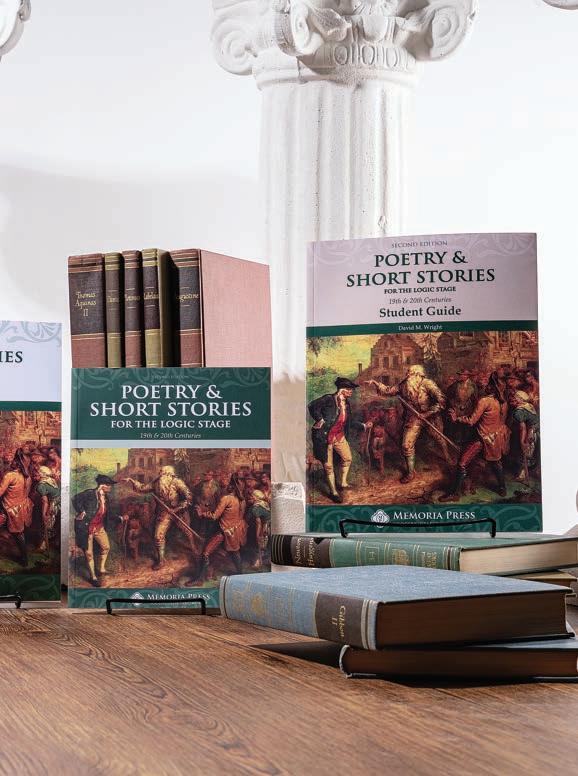
The study of the material world reaps great benefits for the material welfare of mankind: food, fabrics, energysaving devices, heating and cooling, transportation, luxuries of every kind, cures for diseases and pain. Science and technology have transformed our world into one of unimaginable wealth, comfort, and blessings for which we must give thanks and gratitude to all those who have gone before us and those who continue to work with nature to make our lives better. To study science and math is to learn about the spirit and ingenuity of man—to learn about the physical world that is his home and how it can be used for his well-being.
Mathematics is the language of science and the indispensable tool for the study of the natural world. The key to success in all sciences, especially chemistry and physics, is a good math education. Because mathematics, music, and Latin are the three universal languages, they are given a special emphasis in classical education and are required of all students every year. As with Latin and music, we aspire to have the very best mathematics education possible. Languages develop and discipline the mind to a greater degree than other subjects. Mathematics, like all languages, is cumulative, rigorous, and demanding; it develops logical, accurate, and precise thinking habits.
Arithmetic is the art of counting and calculation; it does not require any higher-order thinking skills. There is nothing to understand about arithmetic—it is the memorization of math facts and algorithms. In the trivium model of learning, arithmetic is the focus of kindergarten through sixth grade. Like the alphabet and the Latin grammar, arithmetic is a finite subject, suitable and satisfying to the young child's concrete mind. It is something over which the child can achieve mastery. There aren't many things like that in school or in life. Next to the alphabet, arithmetic is the most useful tool students will ever possess. We tend to take it for

granted, but it should not be rushed over in a hurry to get to higher mathematics. The goal is to master arithmetic with speed and accuracy so that students can do higher math when the time comes, without thinking about arithmetic at all.
Additionally, arithmetic teaches accuracy, precision, and attention to detail. Each time the student checks his own work he learns the importance of quality work and doing a job right. These are priceless skills in character formation and in marketable work skills. Mathematics and Latin are the great enemies of the superficial, shallow, lazy, and inaccurate work that is the natural default mode of the young, and indeed of the human race. Mathematics, like Latin, teaches students to do thorough, honest, accurate work, which is a skill and habit of mind of inestimable worth, far above the content of the subjects themselves.
You cannot practice arithmetic too much in these younger years. It's like piano. It's not enough to know the notes. You have to hit them with speed and accuracy or no one is going to listen to you play. If you plan to play fluently, you must practice for at least an hour a day for many years. Forget composing your own music or playing Mozart—you are not there yet. You need a keyboard sense. And forget attempting algebra—first you need number sense and immediate recall. Games, drills, skip-counting, cypher drills, and challenge problems can help make arithmetic an enjoyable part of the school day.
After mastery of the arithmetic, students are then ready to embark on the study of mathematics, the science and philosophy of relationships. It is a large and varied subject that includes many topics, such as algebra, geometry, and calculus. Topics from the world of mathematics are suitable for students who have reached the age of abstract thinking in middle and high school.
Many modern textbooks do not observe the distinction between arithmetic and mathematics. This is one of the characteristics of progressive education: There is a disdain for basic skills and memorization and a tendency to introduce higher-order skills without laying the foundation to get there. Most students in modern education are pushed too fast in mathematics and fail to experience the kind of mastery that ensures continued success and enjoyment. They are victims of superficial and shallow coverage that emphasizes exposure to advanced concepts without mastery. In these modern textbooks you will see algebra topics included as early as kindergarten, which obscures the necessary arithmetic skills for each grade. The energy and effort of students are dissipated over a variety of topics, many of which are too abstract for students to
understand. Insufficient time is given to basic skills and students do not experience the satisfaction of mastery learning, nor are they adequately prepared for higher math. You can read a book you only partially understand and it won't hurt you, but attempting higher-level math concepts without a mastery of arithmetic is not only confusing, but harmful. Careful preparation is the watchword.
Mathematics is an exact language, one that is unrelenting and unforgiving. A failure to master basics is the cause of the glass ceiling that most students experience in their math education. A small weakness in the beginning, unless corrected, magnifies over time and eventually becomes an insurmountable obstacle to continued progress. Laying a solid foundation in mathematics requires overlearning, achieved by repetition to the point of automaticity.
It is important to get math right. Don't be swayed by Johnny down the street who is doing algebra in third grade while your Johnny is "just" doing multiplication and division. Your Johnny is mastering the math he is learning. And don't be taken in by the idea that computation skills aren't important in the age of the calculator. There is this idea that since we have machines that can do multiplication and division and fractions for us we should not be spending time drilling math facts. But immediate recall of math facts is an absolute necessity in order to do higher-order thinking in math. Developing number sense through mastery is the only sure pathway to success in math in the upper school years.
I see as much confusion about math pedagogy as Latin, probably more. You have to spend the whole year on arithmetic in the lower grades. You cannot devote one unit of the year to computation and the rest of the year to abstract math concepts students aren't ready for and that are hard to teach.
• Primary: The goal in kindergarten through second grade is to learn to print numbers and to learn addition and subtraction facts.
• Third: Third grade introduces multiplication and division, which students continue to work on until mastery.
• Fourth: In fourth grade we master long multiplication.
• Fifth: In fifth grade we master long division, the culmination of arithmetic skills. A long division problem is a long process with room for many mistakes, so students must have all their math facts cold.
• Sixth: In sixth grade we add mastery of fractions, decimals, and percents, which utilize the mastered arithmetic skills.
To succeed in any subject you must know what the priorities are. There are many things to do every day, but to be successful you must do the essential thing first, and you must do things in the right order. The essential thing in the grammar school years is arithmetic.
“Tracy Lee Simmons, author of the acclaimed Climbing Parnassus, has spent a lifetime writing on biography, history, culture, language, and literature—with one common theme: the legacy and values of Western culture in all its brilliant manifestations are critical to the continuance of our civilization, and yet are eroding at an astonishing speed.”
Victor Davis Hanson, author of The Dying Citizen


“Civilized readers will love these essays.”
“This learned but accessible, mannered but buoyant collection of literary review essays sounds the depth and breadth of what it means to be culturally literate.”
Louis Markos, author of From Achilles to Christ
“Gently elegiac, stubbornly hopeful, the essays of Tracy Lee Simmons are fine and timely pieces of writing and thought: poignant reminders that, even now, civilization still glimmers and lives—in dusty bookstores, in majestic histories, and in the mind of man.”
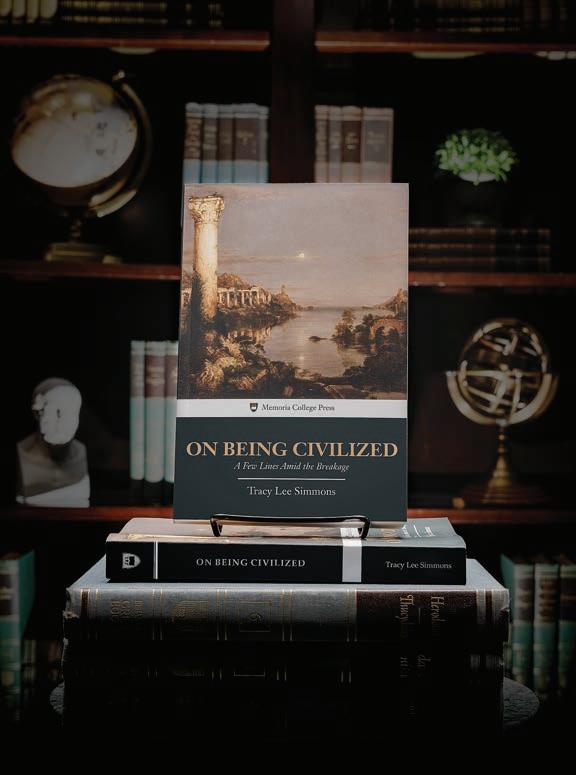 David
David

V. Hicks, author of Norms and Nobility
Andrew Klavan, author of The Truth and Beauty• Simply Classical: A Beautiful Education for Any Child by Cheryl
Swope $26.00• A Defense of Latin and Classical Education edited by Cheryl Lowe $11.55
• Climbing Parnassus: A New Apologia for Greek and Latin by Tracy Lee
Simmons $19.99• From Achilles to Christ: Why Christians Should Read the Pagan Classics by Louis Markos $28.00
• The Recovery of Real Education: A selection of articles from The Classical Teacher $10.45
• The Great Books: A Journey Through 2,500 Years of the West's Classic Literature by Anthony O'Hear $22.00
• The Great Tradition: Classic Readings on What It Means to Be an Educated Human Being edited by Richard M. Gamble $29.99
• The Well-Educated Mind: A Guide to the Classical Education You Never Had by Susan Wise Bauer and Jessie Wise $35.00
• The Well-Trained Mind: A Guide to Classical Education at Home by Susan Wise Bauer $39.95
• How to Read a Book: The Classic Guide to Intelligent Reading by Mortimer J. Adler and Charles Van Doren $19.99
• Figures of Speech: 60 Ways to Turn a Phrase by Arthur Quinn $44.95
• Rhetoric by Aristotle $5.00
• Medieval Literacy: A Compendium of Medieval Knowledge with the Guidance of C. S. Lewis by James Grote $29.95
• Seven Myths About Education by Daisy Christodoulou $42.95
• Why Knowledge Matters: Rescuing Our Children from Failed Educational Theories by E. D. Hirsch, Jr. $33.00
• The Schools We Need: And Why We Don't Have Them by E. D. Hirsch, Jr. $17.95
• Why Freshmen Fail and How to Avoid It! by Carol Reynolds, Ph.D. $21.95
• Fundamentals of the Faith: Essays in Christian Apologetics by Peter Kreeft $17.95
• Handbook of Christian Apologetics: Hundreds of Answers to Crucial Questions by Peter Kreeft and Ronald K. Tacelli $30.00
• Socrates Meets Jesus by Peter Kreeft $22.00
• Orthodoxy by G. K. Chesterton, with introduction by Martin Cothran $12.60
• Mere Christianity by C. S. Lewis $17.99
• The Great Divorce by C. S. Lewis $16.99
• The Screwtape Letters by C. S. Lewis $16.99
• The Abolition of Man by C. S. Lewis $16.99
• A Preface to Paradise Lost by C. S. Lewis $39.99
• Early Christian Writings trans. by Andrew Louth and Maxwell Staniforth $15.00
• The Early Church by Henry Chadwick $18.00
• The History of the Church by Eusebius $19.00
• Teaching Phonics & Word Study in the Intermediate Grades by Wiley Blevins $33.99
• Phonics from A to Z by Wiley Blevins $27.99
• Essentials of Dyslexia Assessment and Intervention by Nancy Mather and Barbara J. Wendling $50.00
$3.95 ea.
Whether you're looking for an elevator pitch for classical education to give a friend, a defense of the place of Latin in classical education, or encouragement in teaching your child to read and write, this series of concise, clear articles in convenient pamphlet format is for you!
What Is Classical Education?
What Is Civilization?
The Liberating Arts
How Latin Develops the Mind
Why Literature Matters
How to Teach Your Child How to Read Latin: The Next Step After Phonics
Christian Studies: How to Have Biblically Literate Children
What Is Classical Rhetoric? A Defense of Penmanship
How to Teach Logic
• Podcasts
• Teaching Guidelines
• Famous Men of Virtue Series
• Memoria Press Speakers' Guild
• and more!




$62.90 set (text, student, teacher, flashcards)
Grades 3-8
Text $19.99 | Student $19.90
Teacher $19.90 | Flashcards $14.20
Myths are everywhere in Western art and literature and are the essential background for a classical education. This is an ideal beginning book regardless of age! Each of the 30 lessons presents facts to know, vocabulary, comprehension questions, and a picture review and activities section.


$55.10 set (text, student, teacher, flashcards)
Grades 4-8
Text $19.45 | eBook $14.00
Student $19.90 | Teacher $19.90
Flashcards $14.20
Meet Romans like Horatius, Caesar, and Marcus Aurelius—history's great men of action. Younger students especially will be fascinated by the abundant action and drama of the great city of Rome, its trials and tribulations, its rise and eventual fall.

$55.10 set (text, student, teacher, flashcards)
Grades 5-8
Text $19.45 | eBook $14.00
Student $19.90 | Teacher $19.90
Flashcards $14.20
Dive into the lives of the famous Greeks—history's great men of thought. Follow Heracles and Odysseus through journeys of myth, fight with Leonidas and Pericles in legendary wars, deliberate with Aristotle and Socrates. Learn of all those who contributed to the scope of Greek accomplishment that is still known today as "The Greek Miracle."

$55.10 set (text, student, teacher, flashcards)
Grades 5-8
Text $19.45 | eBook $14.00
Student $19.90 | Teacher $19.90
Flashcards $14.20
Wind through the "dark ages" by the lights of Clovis, Charlemagne, Alfred the Great, Joan of Arc, and Gutenberg, among many others, and watch as the world transitions from the end of ancient times to the birth of the modern era.
If you don't begin your classical education until middle or high school, we recommend that you start with Year 5.
Year 1 D'Aulaires' Greek Myths
Year 2 Famous Men of Rome
Year 3 Famous Men of the Middle Ages
Year 4 Famous Men of Greece, The Trojan War, and Horatius at the Bridge
Year 5 Iliad, Odyssey, and The Book of the Ancient Greeks


Year 6 The Aeneid and The Book of the Ancient Romans


Year 7 Greek Tragedies (Euripides, Sophocles, Aeschylus)
Year 8 The Divine Comedy
$44.45 set (text, student, teacher)
Grades 6-8
Text $19.45 | eBook $14.00
Student $19.90 | Teacher $19.90
And in the last installment of the series, join Suleiman the Magnificent, Sir Isaac Newton, Peter the Great, George Washington, Napoleon Bonaparte, and many more as they fight to lead and forge the emerging modern world.
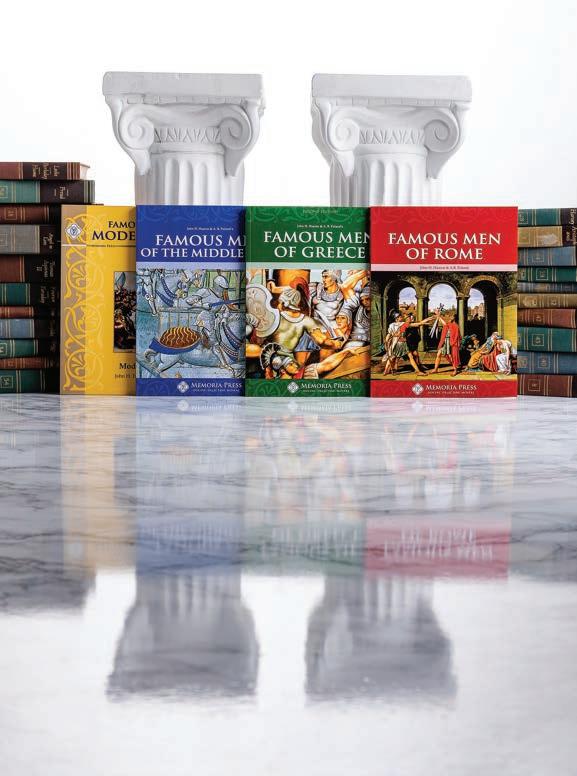
Grades 6+ | $47.44 set ea. (text, student, teacher)
Text $19.50 ea. | *eBook $14.00 ea. | Student $19.90 ea. | Teacher $19.90 ea. (*not available for Renaissance & Reformation)
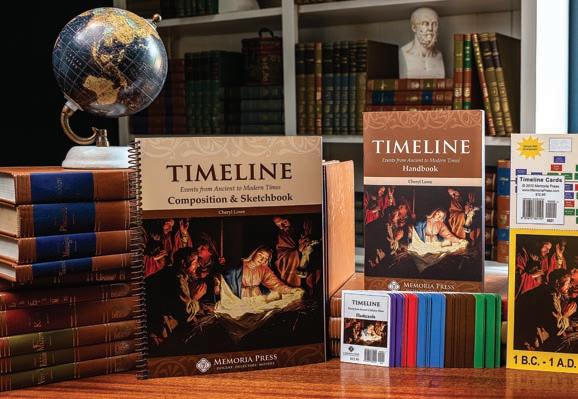
Combine with a Memoria Press Student Guide for a yearlong course. Each guide includes facts to know, vocabulary, comprehension questions, mapwork, and timelines, and the Teacher Guides provide thorough answers as well as unit tests.


Let Dorothy Mills take your student on an adventure to explore the geography, culture, architecture, and most prominent peoples of Egypt, Persia, Anatolia, Israel, and more. Mills covers not only the valuable history and culture of the ancient peoples, but she also gives students an understanding of the people and neighbors out of which Christianity sprung.


The journey continues, starting in Crete and ending in the Hellenistic Age ushered in by Alexander the Great. Your student will learn about the wars and ideas, the art and architecture, the politics and philosophy that have shaped the course of Western civilization since the Greeks laid them out for us.

Like any good Roman course, this one begins with the she-wolf who nurses in infancy the legendary founders of Rome: Romulus and Remus. The rise and fall of a monarchy, the embrace of a republic with the simultaneous dislike for kings, and finally the rise of the Roman Empire teach unforgettable principles about human nature and society. Includes notes on the Roman culture, political system, and religion.



From the foundation of monasteries to the bell towers of universities, from the crowning of Charlemagne to the execution of Joan of Arc, Mills guides students through the spread of Christendom and the founding of a new civilization on the remnants of the Roman Empire.


It would be hard to overstate the reverberating effects of this period on modern history. Politics, philosophy, art, theology—virtually no aspect of Western culture was left unchanged by the Renaissance and Reformation. Mills succeeds marvelously in giving readers a neutral ground on which to base their understanding of this time.
Events from Ancient to Modern Times
Grades 3-7
$48.02 set (sketchbook, handbook, wall cards, flashcards)

Timeline Composition & Sketchbook $11.50
Timeline Handbook $11.50




Timeline Wall Cards $15.70
Timeline Flashcards $14.65

Students will master a total of 60 events from Greek and Roman history, the Middle Ages, American history, and Christian studies.
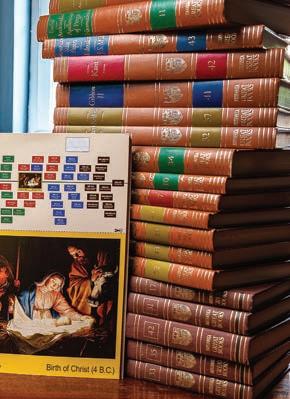
Grade 7
Worksheets $8.95
Key $8.95
To ensure retention and mastery we have created this cumulative review of Memoria Press' States and Capitals , Geography I & II, and Timeline Program .
Large Wall Maps (22'' x 34'') $35.00
Small Wall Maps (11'' x 17'') $21.00

Large Wall Maps (22'' x 34'') $35.00
Small Wall Maps (11'' x 17'') $21.00


 by Olivia Coolidge | Grades 6-8
by Olivia Coolidge | Grades 6-8
Text $8.99 | Student $13.50 | Teacher $13.50
This faithful retelling of the events of the Trojan War is wonderful preparation for reading the Iliad and Odyssey in later years. Your student will become familiar with the main characters, the gods and goddesses, and the storyline of Homer's Iliad and Odyssey, presented in simple but captivating prose. Each lesson in the Student Guide has reading notes, vocabulary, comprehension questions, and an enrichment section with discussion topics, writing, art, and mapwork.


 by Padraic Colum | Grades
by Padraic Colum | Grades
6-8 | $11.55
Padraic Colum introduces young readers to Odysseus, the Greek hero of the Trojan War, who has been away from his home and his family for twenty years. The Adventures of Odysseus & The Tale of Troy has all the essentials of Homer’s epic: the son, Telemachus, searching for news of his father and learning about the events of the Trojan War; the faithful wife, Penelope, refusing to marry again despite a throng of suitors; and Odysseus himself, struggling against monsters, storms, and the wrath of gods to be reunited with his family and regain his place as king of Ithaka.
$11.55
Alfred Church's retelling of Virgil's Aeneid is a great introduction to the story of Aeneas, who escaped from the burning city of Troy and founded Rome, the New Troy. Reading this first will help prepare students to tackle the more difficult writing of Virgil.





Samuel Butler translation | Grades 7+
$96.05 set ea. (text, student, teacher, videos)
$171.88 complete set (Iliad and Odyssey sets)
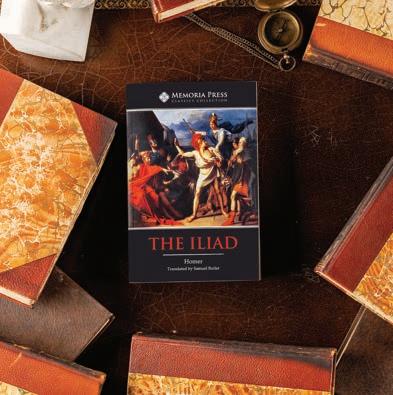
Text $14.70 ea. | eBook $7.00 ea.
Student $13.60 ea. | Teacher $17.80 ea.
Instructional Videos: DVDs or Streaming $55.00 ea. Western civilization begins with the two greatest works of the ancient world: the Iliad and the Odyssey . The enormous influence these books have exerted in Western literature and art make them the perfect place to begin your study of Western culture. Samuel Butler's prose translations are both scholarly and easily accessible to students. The reading notes, focus passages, and comprehension and discussion questions in our Student Guides highlight important events, characters, and themes, allowing your student to more deeply understand these seminal works. The Teacher Manuals include additional contextual background information and teaching tips, as well as complete answers to the Student Guides and unit tests.
David West translation | Grades 8+
$94.19 set (text, student, teacher, videos)
Text $16.00
Student $19.90
Teacher $19.90
Instructional Videos: DVDs or Streaming $55.00
After Homer, the Aeneid is logically your next great book to study. Virgil's epic story of the founding of Rome will come alive when read with the help of our study guide as you continue your quest to master the classics. This is a great preparation for AP Latin also. Our Teacher Manual has inset student pages with teacher notes and background information for each lesson.
$36.91 set (text, student, teacher, medal, pin)
6+
Text $8.95 | Student $8.95 | Teacher $11.50
Medal $5.50 | Lapel Pin $3.95
This study of Macaulay's 70-stanza ballad includes vocabulary, maps, character and plot synopses, meter, comprehension questions, teaching guidelines, and quizzes. Send us a recording of your students reciting the poem, and we'll send them a Winston Churchill Award certificate, medal, and lapel pin.
Grades 10+
$63.47 set (text, student, teacher, quizzes & tests)
$115.72 complete set (all books + streaming videos)
Text $21.00 | Student $19.90
Teacher $19.90 | Quizzes & Tests $6.00
Streaming Instructional Videos $55.00
The Divine Comedy is one of the crown jewels of both Western and Christian literature. This epic, allegorical poem illustrates Dante's spiritual journey of redemption that takes him through the pit of Hell (the Inferno) to the Beatific Vision of God (the Paradiso).
Grades 9+
$235.52 complete set
(3 texts, 3 student guides, 3 teacher guides, 3 instructional videos)
The Oresteian Trilogy by Aeschylus $13.00

The Three Theban Plays by Sophocles $16.00

Medea & Other Plays by Euripides $11.00

Student $19.90 ea. | Teacher $19.90 ea.
Instructional Videos: DVDs or Streaming $45.00 ea.
Grades 10+
Text $13.95
Student $19.90
Teacher $19.90
Cicero's work On Obligations played a large role in Western Christendom but is daunting to read alone. Let us accompany your high schooler as he learns the principles of justice, wisdom, beneficence, courage, and propriety.
Grades 10+
Text $12.95
Student $19.90
Teacher $19.90
The Republic became the blueprint of the U.S. government almost 2,000 years after it was written. In The Laws, Cicero defends his understanding of the upright moral life. His writings became the foundation for the West's philosophical discussion on the natural law.
Aeschylus was the first of the three great tragic playwrights. Join Orestes as he seeks to avenge his father's murder, but discovers, along with us, that revenge only begets revenge—that mercy and litigation are the better ends of justice.
Here is Sophocles' story of Oedipus, fated to unknowingly kill his father and marry his mother. This is the great myth, influencing all subsequent literature. Fate, free will, the quest for knowledge and truth—the glory and downfall of Western civilization.
Euripides further developed the tragedy, instituting the deus ex machina, a prologue, and greater realism. His heroes are less resolute and more psychological, fraught with internal conflict. In them we see the extremes of human nature: cold reason and maniacal passion, nobility and cruelty, triumph and regret, grief and comfort.
The works of Plato can be most profitably read on two simultaneous levels: as works of genius in their own right and as inspired writings used by the God of the Bible to prepare the ancient world for the coming of Christ and the New Testament. Plato, in my mind at least, is the greatest of all philosophers—the culmination of the best of pagan (pre-Christian) wisdom, a wisdom that challenges the mind as much as it fires the imagination and that leaves the soul yearning for more. Though he lacked the direct (or special) revelation afforded to Moses, David, Isaiah, John, and Paul, Plato was nevertheless inspired by something beyond the confines of our natural world. Along with such Greco-Roman sages as Aeschylus, Aristotle, Cicero, and Virgil, Plato glimpsed deep mysteries about the nature of God and man, the earth
Louis Markos is professor in English and Scholar-in-Residence at Houston Christian University, where he holds the Robert H. Ray Chair in Humanities. He is the author of more than a dozen books, including From Achilles to Christ and The Myth Made Fact: Reading Greek and Roman Mythology through Christian Eyes. This article is excerpted from his newest book from InterVarsity Press, From Plato to Christ, which has been awarded the 2023 Parnassus Prize for the Cultivation of the Western Liberal Arts Tradition by Memoria College.
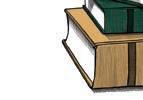
 BY LOUIS MARKOS
BY LOUIS MARKOS


and the heavens, history and eternity, virtue and vice, and love and death that point forward to the fullness of the Judeo-Christian worldview.
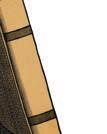
I am aware that such a reading of Plato and his work may seem bizarre at best and anti-intellectual at worst to the modern, post-Enlightenment mind, but we should not forget that many of the fi nest thinkers of the past—men like Origen, Augustine, and Erasmus—held just such a view of Plato and his fellow proto-Christians. The very reason that Aristotle and Virgil could serve as forerunners and guides to the two greatest repositories of medieval Catholic learning (the Summa Theologiae and the Commedia) was because Aquinas and Dante understood that their pagan mentors had access to a wisdom that transcended their time and place. Though they believed that man was fallen both in body and in mind, they also believed that man was created in God's image and still retained the mark of his Creator. True, our reason, conscience, and powers of observation were corrupted by the fall, but they still operated and could afford us limited knowledge of the Good, the True, and the Beautiful. Indeed, so sure was Boethius that fallen man retained, under the wider umbrella of God's grace, the capacity to grope after that which is real (see Acts 17:27) that he att empted, in his Consolation of Philosophy, to embody Christian ethical principles while yet strictly confi ning himself to the wisdom

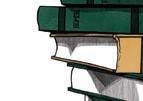

achieved by such pagan thinkers as Plato and Aristotle. Chaucer, author of the third great repository of medieval Catholic learning (Canterbury Tales), clearly believed Boethius's attempt was successful, for his "Knight's Tale" strikes the same literary-philosophical stance: pointing forward to the fuller Christian revelation while limiting its characters to beliefs accessible to the pre-Christian world. And most of those beliefs Chaucer borrowed directly from a book he translated into Middle English: the Consolation of Philosophy
Let me be clear: I shall be treating Plato as a bona fide source of wisdom. Though I shall in no way abdicate my responsibility to measure, test, evaluate, and critique, my primary posture visà-vis Plato will be that of a student learning at a master's feet. Plato was a genius, a vessel through whom much Beauty, Goodness, and Truth was ushered into our world. He was neither flawless nor free from error, but he shone a light that we would do well to attend to—especially if we desire to move up the rising path toward those things that are really real and truly true.
If we read Plato in this spirit, then I believe we will be changed by what we read. We will come to see our world and the next through different eyes; we will reevaluate the worth of things that we once thought dear and perhaps even alter the trajectory of our lives. Plato's dialogues are fun, and the great master is not above tweaking the noses of his readers, but let no one think that they are mere pastimes for idle college students (or professors!). Plato is about serious business, and we should be as well.
Though Plato helped teach the Western world that knowledge is something that should be sought for its own sake rather than as a utilitarian method for achieving power and wealth—a teaching foundational to all liberal arts institutions—he did not consider philosophy to be merely an end in itself. Philosophy properly pursued and wrestled with should lead to a higher and greater end—the contemplation of what Plato called the Good and later Christian theologians called (after Plato) the Beatific Vision. The purpose of Plato's dialectic is not to teach us to play mental games but to propel us forward on the road to greater wisdom and insight. Though Plato the pre-Christian did not know that Truth is ultimately a Person (see John 14:6), he sought it as tenaciously and passionately as Solomon or John or Paul. Let us do the same.
The Education of a Free Man: Introduction to the Liberal Arts
Sing O Muse: The Ancient Epic
The Meaning and Purpose of Literature: The English Novel Mind and Reality: Introduction to Philosophy

Beauty Is Not Optional: Western Art and Music
and more!

Grades 8+
Text $16.99
Student $19.90
Teacher $19.90
Hart gives a scholarly but readable portrait of the rich history of the Christian Church, covering 2,000 years of persecution, belief, discord, and faith. Our study guide walks you through Hart's text with additional background and contextual information, comprehension questions, and discussion questions that tie the history to scriptural passages and explore modern-day issues of faith and belief.



Grades 8+
Text $11.55
Student $18.40
Teacher $19.90
The Acts of the Apostles tells the exciting story of the travels, the teachings, and—in many cases—the martyrdoms of the apostles as they take the message of Jesus Christ from Jerusalem to the ends of the earth in the years immediately following Christ's life, death, and resurrection. This unit study will acquaint students with Christianity's infant stage.


 by Josephus | Grades 9+
by Josephus | Grades 9+
Text $11.55
Student $18.40
Teacher $20.95
"There will not be left a stone upon a stone." Our children may know of Christ's prophecy, but do they learn about its fulfillment? Josephus is regarded as the most trustworthy source on the destruction of Jerusalem in 70 A.D. This follow-up to a study of Scripture is an introduction to the history of Christianity.
Grades 3-6
Christian Studies I: All Major Bible Stories up to the Entry into Canaan
Christian Studies II: The Rise and Fall of Israel and the Period of the Prophets
Christian Studies III: All Major New Testament Stories







$179.07 set
(Christian Studies I-III student & teacher, Golden Children's Bible, New Testament, Old Testament, and Memory Verse Flashcards)
Student $19.90 ea. | Teacher $23.05 ea. | Golden Children's Bible $22.99
Memory Verse Flashcards $17.80 | Old Testament Flashcards $14.65 | New Testament Flashcards $14.65
Biblical literacy is just as important as cultural, moral, and functional literacy, and the material we use to teach children their faith should be just as rigorous and demanding as any other important subject. Our Christian Studies series is a systematic study of the major events and characters in Salvation History, using The Golden Children's Bible. Students work through a Bible timeline from Creation to Christ, memorize Bible geography, the books of the Bible, people and events in order, and discuss vocabulary and basic theological concepts common to all Christian faith traditions. At the end of this course your student will be thoroughly grounded in the knowledge necessary for advanced Christian studies. Each lesson in the Student Guide includes facts to know, a memory verse, comprehension questions, and geography and timeline activities. The Teacher Manual contains thorough answers and additional insights and background information for each lesson, as well as unit tests.


Grades K-2
The Story Bible $29.99

Christian Studies Enrichment $14.65
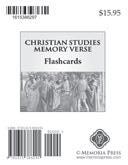


The Story Bible is written especially for children who are beginning to read. The enrichment guide helps facilitate oral discussion for each Bible lesson.
Grades 3-6
$22.99
We chose this Bible to use with our Christian Studies I-III series for its simplified but poetically appealing King James text and beautiful illustrations. The stories are broken into small, digestible chunks, and written on a third-sixth grade reading level.
Grades 6-8
Text $13.65
Student $19.90
Teacher $23.05
This course takes students back through the highlights of the Bible, and reviews drill questions, memory passages, and more! It can serve as a review course for Christian Studies I-III or as a survey study of the Bible. Our text gives students an overview and background information for each book of the Bible.
Grades 9+
Student $19.90
Teacher $23.05
The Early Church $18.00

The History of the Church $19.00
Eusebius, the bishop of Caesarea, wrote the first book to recount the struggles and victories of the first followers of Christ. In this year-long course, Chadwick's The Early Church is used as the main text, and students are directed to Eusebius' The History of the Church when ancient testimony is appropriate.
City of God by St. Augustine, Vernon J. Bourke ed.



Grades 10+
Text $19.00
Student $19.90
Teacher $20.95
Quizzes & Tests $6.00
City of God , arguably Augustine's greatest book, is the source of some of Western society's greatest and most cherished beliefs. Augustine's book serves as the cultural fountainhead of all that followed, and it is unlikely that it will ever be equaled. The Teacher Guide contains helpful chapter summaries and an answer key for the Student Guide
The Memoria Press YouTube channel is full of video resources for your educational journey – podcasts that tackle the heart of classical learning, deep dives into the virtues of Famous Men, Teaching Guidelines on a variety of subjects, and much more!
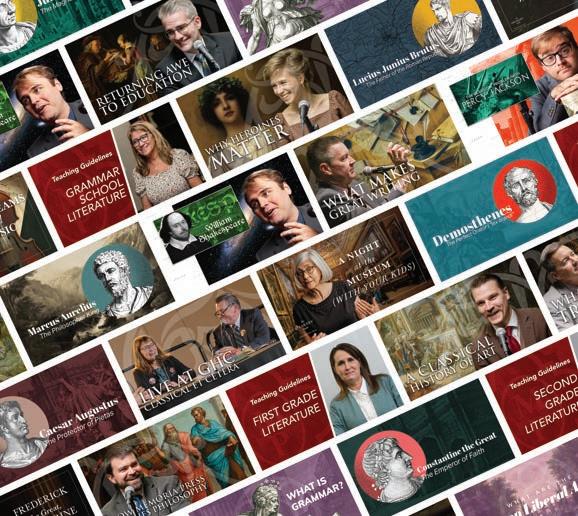

SUBSCRIBE TODAY AT: YouTube.com/MemoriaPress
Having taught everything from phonics to Caesar, I can affirm that the skills acquired in the beginning years are of vital importance to the later years. If you are a high school teacher you probably experience every day the results of inattention to basic skills in K-2. Our students will not achieve the excellence we desire unless we come to a better appreciation of the primary school and recognize that life-long habits are formed there, good and bad.

Kindergarten Read-Aloud Set pictured. For a complete list of books in each set, visit MemoriaPress.com.
Choose from:
• Jr. Kindergarten Read-Aloud $365.57
• Kindergarten Read-Aloud $373.54
• Kindergarten Science & Enrichment $362.56
• First Grade Read-Aloud $384.50
• First Grade Science & Enrichment $269.51
• Second Grade Read-Aloud $372.55
• Second Grade Science & Enrichment $196.64
• Third Grade Read-Aloud Novels $185.82
• Third Grade Read-Aloud Picture Books $349.26
• Third Grade American $146.73
To complete the Literature & Enrichment portion of the K-2 curriculum, you will need the weekly read-alouds. You may already own many of these classic books, but you can also gather them at the library or purchase them from us. We schedule Literature ReadAlouds and American Studies Read-Alouds for older students in our 3rd-6th grade Curriculum Manuals. These grammar school sets are supplemental as time and interest permit.
• Prima Latina
• Latina Christiana
• Latin Forms Series
• Latin Recitation
• Lingua Angelica
Streaming Audio:
• Music Appreciation
• First Start French I & II
• Elementar y Greek I-III
• Greek Forms Series
Streaming Video:
• Classical Composition
• Traditional Logic I & II
• Material Logic
• Classical Rhetoric
• Prima Latina
• Latina Christiana
• First Form Latin
• Second Form Latin
• Third Form Latin
• Fourth Form Latin
• First Form Greek
• Henle Latin First Year
• Latin Recitation
• Greek Tragedies
• Divine Comedy
• Aeneid
• Iliad
• Odyssey
• Algebra I
• Algebra II
• Biology
• Kindergarten Phonics & Reading
• A Classical History of Art
Our Streaming Instructional Videos are a digital alternative to physical DVDs, and require only a device (computer, phone, tablet) with internet access. They include the same thorough and engaging teacher instruction as our DVDs. Purchase of a subscription gives you
LIFETIME ACCESS to the videos!
Stream today at MemoriaPress.com/streaming
• Fourth Grade Read-Aloud $141.70
• Fourth Grade American $81.90
• Fifth Grade Read-Aloud $108.08
• Fifth Grade American $66.88
• Sixth Grade Read-Aloud $86.76
• Sixth Grade American $60.90
Don't need an entire package?
$3.00 - $16.00 per subject
Memoria Press' lesson plans by subject allow you to tailor the Classical Core Curriculum to your own needs. These plans retain our week-at-a-glance layout, scheduling the individual subjects of each grade so you can mix and match as you need.
✓ Latin Forms Series
✓ Literature
✓ Classical Studies
✓ Kindergarten Phonics
✓ Christian Studies
✓ Geography
✓ Math & Science
✓ AND MORE!
The Classical Core Curriculum is a complete classical Christian curriculum that emphasizes the traditional liberal arts of language and mathematics and the cultural heritage of the Christian West as expressed in the great works of history and literature. The curriculum has an early focus on the basic skills of reading, writing, and arithmetic, and a special emphasis on Latin. Latin is the best way to gain an academic vocabulary and to learn the formal system of grammar, and is, along with math, the best early critical thinking skills training. The study of the cultures of Athens and Rome, as well as biblical and Church history, is designed to provide a basis for a proper understanding of European and American history.
$224.34 Full Set (all books + Curriculum Manual)
$30 Curriculum Manual Only
• Preschool Curriculum Manual
• Prayers for Children
• Jesus Is With Me
• Jesus Hears Me
• Jesus Knows Me

• Big Red Barn
• The Best Mouse Cookie
• Little Fur Family
• Bunny's Noisy Book
• From Head to Toe
• Goodnight Moon
• Polar Bear, Polar Bear, What Do You Hear?
• Brown Bear, Brown Bear, What Do You See?
• Numbers, Colors, Shapes
$154.17 Full Set (all books + 2-Day Curriculum Manual)
$68.31 Consumable Books Set (for additional students)
$30 Curriculum Manual Only
$365.57 Supplemental Read-Aloud Program


Character Building Supplements: Myself & Others Book I Core Set $59.76
Myself & Others Book II Core Set $23.35
• Jr. Kindergarten Curriculum Manual

• Counting With Numbers
• Numbers & Colors
• Prayers for Children
• Alphabet Books 1 & 2
• Numbers Coloring Book
• Alphabet Coloring Book
• Alphabet Flashcards

• Alphabet Manuscript Wall Charts
• Richard Scarry's Best Mother Goose Ever

• Big Thoughts for Little People (Devotional)
• Hailstones and Halibut Bones (Poetry)
• The Book of Crafts: Jr. Kindergarten
• My Very Own Scissors Book
• The Very Busy Spider
• Good Night, Gorilla
• The Tale of Peter Rabbit
• Fuzzy Yellow Ducklings
• My Very First Book of Shapes

• ABC: An Amazing Alphabet Book!
• Put Me in the Zoo
• Hand, Hand, Fingers, Thumb
• Cars and Trucks From A to Z
• My First Counting Book
• The Animals' Christmas Eve
• Big Dog ... Little Dog
• Mr. Brown Can Moo! Can You?
• A Children's Treasury of Nursery Rhymes
• 1 Is One
5-Day Junior Kindergarten Curriculum now available! | $224.59
Check out the book list: MemoriaPress.com/JK-5

Curriculum prices valid as of printing. Subject to change.
Curriculum Manual Only $30

Consumables Only $170.34
Supplemental Read-Aloud Sets also available!









Kindergarten Enrichment; Kindergarten Book of Crafts; Kindergarten Art Cards; Animals, Animals; A Child's Book of Poems; Music Enrichment

Lesson Plans for One Year
RETAIL $654.97
PACKAGE PRICE $493.66
Numbers Book set; Rod & Staff Arithmetic 1 Student (Part 1), Teacher, and Practice Sheets; Arithmetic Flashcards: Addition & Subtraction; Memoria Math Challenge A





CHRISTIAN
The Story Bible; Christian Studies Enrichment






100 Days of Summer Reading Book I; Classical Phonics; Phonics Flashcards; First Start Reading A-D; First Start Reading Storybooks A-D; Phonics & Reading Streaming Instructional Videos; Christian Liberty Nature Reader, Book K; Scamp and Tramp; Soft and White; Fun in the Sun; Animal Alphabet Coloring Book; Kindergarten Phonics Supplemental Workbook; Manuscript Practice Sheets; Cut & Paste Book
Kindergarten Morning Work; Manner of the Week Wall Charts and Flashcards

Copybook I; Composition & Sketchbook I

OPTIONAL
For extra practice as needed.
Primary Phonics Readers, Set 1











NEED TO CUSTOMIZE?
Go to MemoriaPress.com or call 502-966-9115.
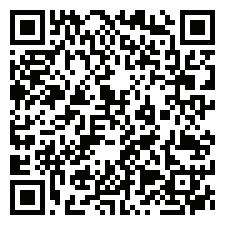
RETAIL
$531.52 PACKAGE PRICE

$402.23




LITERATURE
Curriculum Manual Only $30 Consumables Only $188.04
Supplemental Read-Aloud Sets also available!
CURRICULUM MANUAL
StoryTime Treasures set; More StoryTime Treasures set; Winter on the Farm; Christmas in the Big Woods; Little House Christmas Treasury; 100 Days of Summer Reading Book II
Lesson Plans for One Year
PHONICS & SPELLING
First Start Reading Book E; First Start Reading Storybook E; Traditional Spelling I set










PENMANSHIP
New American Cursive 1; Copybook II; Composition & Sketchbook II; Cursive Practice Sheets I; Alphabet Wall Poster; Summer Cursive; Penmanship Tablet


ENRICHMENT
First Grade Book of Crafts; First Grade Enrichment; First Grade Art Cards

MATH
Rod & Staff Arithmetic 1 Student (Part 2); Rod & Staff Arithmetic 2 Student (Unit 1), Teacher (Part 1), and Practice Sheets Book 1; Memoria Math Challenge B


For extra practice as needed.
Primary Phonics Readers, Sets 2-6


American Language Series
OR
NEW USER ADD-ON SET $156.02
New to Memoria Press? You need these items from prior years.
Classical Phonics; Phonics Flashcards; A Child's Book of Poems; Animals, Animals; The Story Bible; Christian Studies Enrichment; Rod & Staff Arithmetic 1 Teacher Manual and Practice Sheets; Arithmetic Flashcards: Addition & Subtraction; Music Enrichment







NEED TO CUSTOMIZE?
Go to MemoriaPress.com or call 502-966-9115.
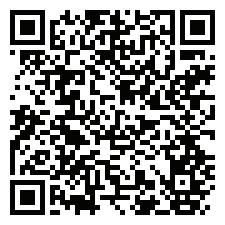
Curriculum Manual Only $30
Consumables Only $245.31
Supplemental Read-Aloud Sets also available!
CURRICULUM MANUAL


Lesson Plans for One Year
SCIENCE
Rod & Staff Patterns of Nature set



AMERICAN/ MODERN
Stories of Great Americans for Little Americans





LATIN & GRAMMAR
Prima Latina complete set; Introduction to English Grammar


















RETAIL $660.03
PACKAGE PRICE $500.42
PENMANSHIP
New American Cursive 2; Copybook Cursive I; Composition & Sketchbook II; Prima Latina Copybook; Penmanship Tablet

MATH
Rod & Staff Arithmetic 2 Student (Units 2-4), Teacher (Part 2), Practice Sheets Book 2, Supplemental Pack; Memoria Math Challenge C; Memoria Math Supplemental Workbook: Review of First Grade Math



Instructional Videos available as Streaming or DVDs!

MORNING WORK
English Grammar Practice
LITERATURE
Second Grade Literature set; Second Grade Literature Dictionary; 100 Days of Summer Reading Book III






ENRICHMENT
Second Grade Enrichment; Second Grade Book of Crafts; Second Grade Art Cards
NEW USER ADD-ON SET $144.32

PHONICS & SPELLING


OPTIONAL
Cursive Practice Sheets II; Easy Reader Classics
New to Memoria Press? You need these items from prior years.
Classical Phonics; Phonics Flashcards; A Child's Book of Poems; Animals, Animals; Music Enrichment; The Story Bible; Christian Studies Enrichment; Arithmetic Flashcards: Addition & Subtraction; Rod & Staff Arithmetic 2 Student (Unit 1), Practice Sheets Book 1, and Teacher (Part 1)
Traditional Spelling II set

RETAIL $963.56 PACKAGE PRICE $647.60

LATIN
Latina Christiana set, LC Review Worksheets set; Latina Christiana: Games & Puzzles set




Curriculum Manual Only $30 Consumables Only $304.00 Supplemental Read-Aloud Sets also available!

SCIENCE
Mammals set

CURRICULUM MANUAL


Lesson Plans for One Year
AMERICAN/MODERN
States & Capitals set; FlashKids States & Capitals Flashcards


WRITING
All Things Fun & Fascinating
PENMANSHIP
New American Cursive 3
MATH
Rod & Staff Arithmetic 3 Student, Teacher, Supplemental Worksheets and Key, Blacklines, Speed Drills; Multiplication Flashcards: 0 to 12; Division Flashcards: 0 to 12
CLASSICAL
D'Aulaires' Greek Myths set; Timeline Program







GRAMMAR
English Grammar Recitation and English Grammar Recitation Workbook I set and Flashcards; Core Skills Language Arts 3





SPELLING


Traditional Spelling III set
CHRISTIAN
Christian Studies I set; The Golden Children's Bible; Memory Verse Flashcards; Old Testament Flashcards
LITERATURE/POETRY

Third Grade Literature set; Poetry for the Grammar Stage set; The Best Christmas Pageant Ever









Instructional Videos available as Streaming or DVDs!


OPTIONAL Cursive Practice Sheets III
New to Memoria Press? You need this item from Second Grade. Latina Christiana Flashcards $16.75

Curriculum Manual Only $30
Consumables Only $146.99
Supplemental Read-Aloud Sets also available! RETAIL $539.91


MATH
Rod & Staff Arithmetic 4 Student, Teacher (Parts 1-2), Tests, Speed Drills, Speed Drill Packet




SPELLING
Traditional Spelling IV
CURRICULUM MANUAL

Lesson Plans for One Year
PACKAGE PRICE $373.76
LITERATURE
Fourth Grade Literature set; Papa Panov's Special Christmas; Twelve Days of Christmas; A Promise Kept: The Story of Christmas; Good King Wenceslas




PENMANSHIP
Copybook Cursive II


WRITING
Classical Composition I: Fable Student, Teacher, Videos




SCIENCE
The Book of Astronomy set


GRAMMAR
English Grammar Recitation Workbook II set; Core Skills Language Arts 4







In our third grade package, students complete half of D'Aulaires' Greek Myths, Latina Christiana, Christian Studies I, and States and Capitals, as well as parts of Poetry for the Grammar Stage, which they will continue to use through seventh grade. The purchase of this package assumes that you have the books that are in our third grade package and have completed the first half of them.
If you are starting the Classical Core Curriculum in fourth grade, we have a discounted transitional package for you: $693.74 Grade 4 for New Users
Visit MemoriaPress.com for a complete book list and more information.


NEED TO CUSTOMIZE?
Go to MemoriaPress.com or call 502-966-9115.
Instructional Videos available as Streaming or DVDs!
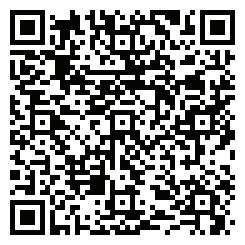
Latin & Greek
Alphabet Books; Alphabet Flashcards; Alphabet Coloring Book (p. 72); My Very Own Scissors Book (p. 71); Manuscript Charts (p. 79)
Kindergarten Phonics Supplemental Workbook; Classical Phonics; First Start Reading A-D; 100 Days of Summer Reading I; Phonics Flashcards (p. 74); Animal Alphabet Coloring Book; American Language Readers; Nature Reader K
Traditional Spelling I (p. 75); StoryTime and More StoryTime Treasures Literature Sets (p. 14); 100 Days of Summer Reading II; First Start Reading Book E (p. 74)
Traditional Spelling II (p. 75); 100 Days of Summer Reading III (p. 74); Second Grade Literature Set (p. 14)
Classical & Christian Prayers for Children; Big Thoughts for Little People
The Alphabet Books and Numbers & Colors are used for Penmanship practice.

Copybook I; Composition & Sketchbook I (p. 79)
Copybook II; Composition & Sketchbook II; New American Cursive 1; Penmanship Tablet; Alphabet Wall Poster; Cursive Practice Sheets; Summer Cursive (pp. 78-79)
(p. 37)
Units 2-4; Memoria Math Challenge C (p. 73)
New American Cursive 2 (p. 78); Copybook Cursive I; Composition & Sketchbook II (p. 79); Prima Latina Copybook (p. 8); Penmanship Tablet
Book of Crafts, Jr. K (p. 70); Richard Scarry's Mother Goose; Hailstones and Halibut Bones

Kindergarten Art Cards (p. 67); Kindergarten Enrichment; Book of Crafts, K; Music Enrichment (p. 70); Animals, Animals; A Child's Book of Poems
First Grade Art Cards (p. 67); First Grade Enrichment; First Grade Book of Crafts; Music Enrichment (p. 70); Animals, Animals; A Child's Book of Poems
Second Grade Enrichment; Second Grade Book of Crafts; Music Enrichment (p. 70); Second Grade Art Cards (p. 67); Patterns of Nature; Animals, Animals; A Child's Book of Poems
English Grammar Practice (p. 84); Introduction to English Grammar (p. 4)
Kindergarten Enrichment is used for American/Modern Studies.
First Grade Enrichment is used for American/Modern Studies.
Stories of Great Americans for Little Americans (p. 63)
Traditional Spelling III (p. 75); Third Grade Literature Set (p. 15); Poetry for the Grammar Stage (p. 22)
Traditional Spelling IV (p. 75); Fourth Grade Literature Set (p. 15); Poetry for the Grammar Stage (p. 22)
Spelling Workout F; Fifth Grade Literature Set (p. 16); Poetry for the Grammar Stage (p. 22)
Spelling Workout G; Sixth Grade Literature Set (p. 16); Poetry for the Grammar Stage (p. 22)
D'Aulaires' Book of Greek Myths (p. 28); Timeline Program (p. 31); Golden Children's Bible; Christian Studies I (p. 37)
37)
Famous Men of the Middle Ages (p. 28); Golden Children's Bible; Christian Studies III (p. 37)
All Things Fun & Fascinating (p. 84); New American Cursive 3 (p. 78)
Classical Composition: Fable (p. 84); Copybook Cursive II (p. 79)
Classical Composition: Narrative (p. 84); Copybook Cursive III (p. 79)
Classical Composition: Chreia & Maxim (p. 84); Copybook Cursive IV (p. 79)
Mammals (p. 91)
Book of Astronomy (p. 91)
Book of Insects (p. 91)
Book of Birds (p. 91); Exploring the History of Medicine (p. 92)
Core Skills Language Arts 3; English Grammar Recitation I (p. 84)
Skills Language Arts
Spelling Workout H; Seventh Grade Literature Set (p. 17); Poetry for the Grammar Stage (p. 22)
Third Form Latin (p. 7); Greek Alphabet (p. 64)
Eighth Grade Literature Set (p. 17); Poetry & Short Stories for the Logic Stage (p. 22)
Ninth Grade Literature Set (p. 18); The British Tradition I (p. 22); Book of the Middle Ages (p. 31)
Tenth Grade Literature Set (p. 18); The British Tradition II (p. 22)
Fourth Form Latin (p. 7); Henle I (p. 10); First Form Greek (p. 65) (optional)
Henle Latin II (p. 10); Latin Grammar for the Grammar Stage (p. 9); Second Form Greek (p. 65) (optional)
37)
32)
Greek Tragedies (p. 33); History of the Early Church (p. 37)
Prealgebra (p. 73)
Classical Composition: Refutation & Confirmation (p. 84)
Book of Trees (p. 91); Exploring the World of Biology (p. 92)
VideoText Algebra, Year One (p. 73)
VideoText Algebra, Year Two (p. 73)
VideoText Geometry (p. 73)
$5 off any order: Use coupon code
Classical Composition: Common Topic (p. 84)
Classical Composition: Encomium, Invective, & Comparison (p. 84)
Classical Composition: Characterization and Description (p. 84)
Physical Science (p. 92)
General Biology (p. 92)
Chemistry (p. 92)
English Grammar Recitation IV (p. 84); Core Skills Language Arts 7
English Grammar Recitation V (p. 84); Core Skills Language Arts 8
Traditional Logic I & II (p. 87)
Material Logic (p. 87)
200 Questions About American History; 13 Colonies (p. 62); Story of the World, Vol. 4
Geography III (p. 61)
(p.



RETAIL



CURRICULUM MANUAL Lesson Plans for One Year

Curriculum Manual Only $30 Consumables Only $227.26 Supplemental Read-Aloud Sets also available!






First Form Latin complete set; Lingua Angelica I set; Latin Grammar Recitation













Arithmetic 5 Student, Teacher (Parts 1-2), Tests, Speed Drills WRITING





AMERICAN/MODERN
Geography I set, including The United States Review set and Geography Flashcards





CLASSICAL
MATH Rod
SPELLING




Famous Men of Rome set



CHRISTIAN
Timeline Program; Poetry for the Grammar Stage set; English Grammar Recitation; English Grammar Recitation Flashcards; The Golden Children's Bible; Old Testament Flashcards; Memory Verse Flashcards


Instructional Videos available as Streaming or DVDs!
NEED TO CUSTOMIZE?
Go to MemoriaPress.com or call 502-966-9115.

Curriculum Manual Only $30 Consumables Only $241.63


Supplemental Read-Aloud Sets also available!

LATIN

Second Form Latin complete set




AMERICAN/MODERN
Geography II set, including Geography I Review set




CURRICULUM MANUAL Lesson Plans for One Year

RETAIL $894.87
PACKAGE PRICE $593.28
MATH
Rod & Staff Mathematics 6 Student, Teacher (Parts 1-2), Quizzes & Speed Tests, Tests










WRITING
Classical Composition III: Chreia & Maxim Student, Teacher, Videos
CLASSICAL
Famous Men of the Middle Ages set



GRAMMAR
English Grammar Recitation Workbook III set; Core Skills Language Arts 6






SPELLING
Spelling Workout G set

SCIENCE
The Book of Birds set; Exploring the History of Medicine set





LITERATURE
Sixth Grade Literature set




CHRISTIAN Christian Studies III set; New Testament Flashcards; Copybook Cursive IV



Instructional Videos available as Streaming or DVDs!
NEED TO CUSTOMIZE?
Go to MemoriaPress.com or call 502-966-9115.
NEW USER ADD-ON SET $156.67 – New to Memoria Press? You need these items from prior years. Timeline Program; Poetry for the Grammar Stage set; English Grammar Recitation; English Grammar Recitation Flashcards; The Golden Children's Bible; Memory Verse Flashcards; Geography Flashcards
RETAIL
$1,028.43 PACKAGE PRICE
$659.09
CURRICULUM MANUAL
Lesson Plans for One Year
LATIN
Third Form Latin complete set



Curriculum Manual Only $30 Consumables Only $269.06


WRITING
Classical Composition IV: Refutation & Confirmation Student, Teacher, Videos

SPELLING

Spelling Workout H set
AMERICAN/MODERN
The Story of the Thirteen Colonies & the Great Republic set; American History Outline set; 200 Questions About American History set and Flashcards; The Story of the World, Vol. 4

















Famous Men of Greece set; Horatius at the Bridge set; The Greek Alphabet set





CHRISTIAN
Christian Studies IV set


MATH
College of the Redwoods Prealgebra set


The Book of Trees set; Exploring the World of Biology set






GRAMMAR
English Grammar Recitation Workbook IV set; Core Skills Language Arts 7




LITERATURE
Seventh Grade Literature set
Instructional Videos available as Streaming or DVDs!
NEW USER ADD-ON SET $106.44 – New to Memoria Press? You need these items from prior years.
Timeline Program; Poetry for the Grammar Stage set; English Grammar Recitation; English Grammar Recitation Flashcards



REVIEW
Geography & Timeline Review
Curriculum Manual Only $30 Consumables Only $229.33


GRAMMAR
English Grammar Recitation Workbook V set; Core Skills Language Arts 8





CLASSICAL
The Book of the Ancient Greeks set; The Iliad set; The Odyssey set









CURRICULUM
MANUAL
Lesson Plans for One Year
RETAIL $1,418.15
PACKAGE PRICE $858.38
LATIN
Fourth Form Latin complete set; Henle Latin First Year







WRITING
Classical Composition V: Common Topic Student, Teacher, Videos

CHRISTIAN
The Book of the Ancient World set


MATH
VideoText Algebra, Year One (Modules A-C)*


SCIENCE
Novare Physical Science Text and Digital Resources
AMERICAN/MODERN
Geography III Text, Student, Teacher and Classroom Atlas



LITERATURE/POETRY
Eighth Grade Literature set; Poetry & Short Stories for the Logic Stage: 19th and 20th Centuries set; Bard of Avon





OPTIONAL
First Form Greek
NEW USER ADD-ON SET $38.16 – New to Memoria Press? You need these items from prior years.
Geography Flashcards; English Grammar Recitation; English Grammar Recitation Flashcards



Instructional Videos available as Streaming or DVDs!
NEED TO CUSTOMIZE?
Go to MemoriaPress.com or call 502-966-9115.
RETAIL
$1,442.06 PACKAGE PRICE
$898.22
CURRICULUM MANUAL


Lesson Plans for One Year
LATIN
Henle Latin Second Year Student Guide, Flashcards, Quizzes & Tests, Text, and Key; Latin Grammar for the Grammar Stage




Curriculum Manual Only $30 Consumables Only $211.91
CLASSICAL
The Book of the Ancient Romans set; The Aeneid set












LOGIC
Traditional Logic I & II complete sets


WRITING
Classical Composition VI: Encomium, Invective, & Comparison Student, Teacher, Videos
CHRISTIAN
The Story of Christianity set


LITERATURE/POETRY
Ninth Grade Literature set; The British Tradition I: Poetry, Prose, & Drama set; The Book of the Middle Ages








AMERICAN/MODERN
Renaissance & Reformation Times set

SCIENCE
Novare General Biology Text and Digital Resources, Biology Coloring Workbook

MATH
VideoText Algebra, Year Two (Modules D-F)*


*only Module D is pictured
NEED TO CUSTOMIZE?
Go to MemoriaPress.com or call 502-966-9115.
Instructional Videos available as Streaming or DVDs!
Curriculum Manual Only $30
Consumables Only $221.64
CURRICULUM MANUAL
Lesson Plans for One Year
LATIN
Mueller's Caesar (De Bello Gallico) Text, Teacher's Guide, and Lesson Plans


CHRISTIAN
History of the Early Church set

RETAIL $1,863.70
PACKAGE PRICE $1,140.47
CLASSICAL
Medea & Other Plays set; The Three Theban Plays set; The Oresteian Trilogy set





AMERICAN/MODERN
A History of Medieval Europe set




WRITING
Classical Composition VII: Characterization and Classical Composition VIII: Description Student, Teacher, Videos
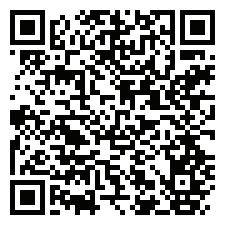




LITERATURE/POETRY
Tenth Grade Literature set; The British Tradition II: Poetry & Prose set








Novare General Chemistry Text, Digital Resources, Complete Solutions Manual, Student Lab Report Handbook, and Experiments for High School at Home



LOGIC
Material Logic complete set




MATH
VideoText Geometry (Modules A-E)*




*only Module A is pictured
Instructional Videos available as Streaming or DVDs!
NEED TO CUSTOMIZE? Go to MemoriaPress.com or call 502-966-9115.
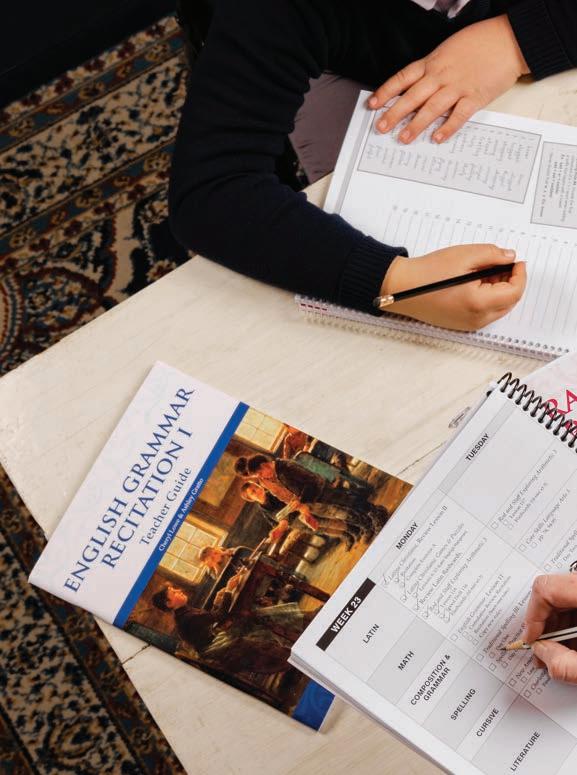
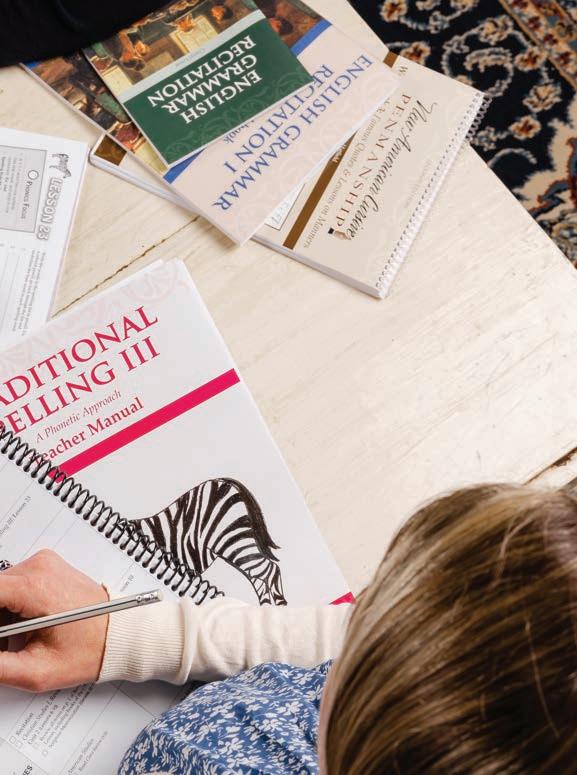

Several years ago, I was asked by a lady who was starting a classical school if I would come give a speech to an education group in her community. I had planned my usual talk in which I discuss the advantages of a classical Christian education, but on the way there found out that this "education and business partnership" group was made up largely of teachers and administrators from the local public school district. And, as we sat eating lunch after I arrived, I was informed that the group really was almost exclusively public educators, with maybe five business people in attendance. It didn't take me long to conclude that my speech about the glories of private classical Christian education would be completely ineffective with a group of mostly public educators. I might even get run out on a rail. And the business people? Wouldn't they be even less interested in my talk about the idea of education as training in wisdom and virtue?
So I began my talk, trying to adapt it as I could to the new situation. I talked about the practical value of a liberal arts education, of reading history and literature, and of the benefit these things had for students whose greatest need is be taught how to be human beings who can think and act well, and why in knowing these things they would be better at any job.
Sitting in the center of the room was a woman who (I was later informed) was the superintendent of the local school district. She sat there, right in my line of sight, glaring at me the whole time. When I spoke of the value of Western civilization, she glared. When I talked about the communication skills acquired by reading Shakespeare and Dickens, she glared some more. And when I talked about the mental skills acquired by learning Latin? Well, let's just say she looked like she would prefer to be anywhere else but in that room.
But all was not entirely lost. As a speaker, you learn to direct your glance at people who do seem to appreciate your message. You try to ignore those who do not like what you are saying and focus your vision on those who do. In this case, I had a lot of people to ignore. Most of the people in the room clearly had no use for my message, but five people in the room were nodding their heads through nearly all of my remarks.
After I finished, most of the audience, clearly relieved, left quickly. But five people stayed to talk with me. These five business people—the same ones who had nodded throughout my speech—appreciated what I had to say and wanted to tell me how much they agreed with me.
"Let me tell you," said a young professional woman who owned a business in the community, "what studying Latin in school did for me." And she launched off on a
Martin Cothran is editor of The Classical Teacher, author of Traditional Logic Books I & II, Material Logic, and Classical Rhetoric, and provost of Memoria College.five-minute disquisition on the benefits of what the nowabsent educators considered a dead and useless language. The others had similar stories to tell about how studying the humanities had helped them in business and in life.
In the years since I gave that talk, I have come to realize how big the disconnect is between the education world and the professional world when it comes to agreeing on the knowledge and skills needed to succeed in the modern world.
Schools have largely abandoned the teaching of history and literature. (Ask any recent grad how many books he or she had to read over the course of a twelveyear education.) And Latin? It was expelled from the curriculum of the vast majority of schools decades ago. The message coming from the education establishment today is centered on one particular thing: STEM—Science, Technology, Engineering, and Mathematics. The old idea of schools as places that formed the souls of students has now been fully replaced by a new idea that the purpose of schools is to teach children the narrow skills they think students will need to get a job in the modern economy. And—what is much worse—the people who run our schools see no connection between these two goals.
The chief problem is this: What schools think the modern economy needs and what leaders in the modern economy say they need are two entirely different things. Like those five business people at my talk, most of the people who are successful in business know that they need job candidates who know how to think and how to communicate. They also know that these skills are not best taught in a narrow vocational program.
Schools misunderstand the current economy. They think that all or most jobs are programming jobs. Yes, there are programming jobs and, yes, they are wellpaying, but the vast majority of jobs at even a specialized tech company are not tech jobs, but jobs in marketing and customer service—in other words, communication jobs.
Not only do schools not understand the current job world, but they are very poor predictors of what the future economy will require. When I was in college we were told that the computer languages of the future were Pascal and Fortran, but when we graduated those languages were already on their way out. In fact, one of the most common criticisms of college computer science programs from the tech industry is that they are out of touch with their industry.
In his Wall Street Journal article, "Why I'm Not Looking to Hire Computer-Science Majors," Daniel Gelernter, CEO of the tech startup Dittach, says: "The thing I don't look for in a developer is a degree in computer science. University computer science departments are in miserable shape: Ten years behind in a field that changes every ten minutes." There is little reason to think that the situation has improved since he wrote the article in 2015.
If colleges are out of touch with the computer industry, just imagine how out of touch your local school system is. And what makes us think that schools would be able to prepare students for the job world even if they knew what it needed? They would need to have trained, experienced tech professionals who knew what needed to be taught and how to teach it. Where are we going to find these people who are willing to give up the lucrative salaries they could be making in order to teach in our increasingly dysfunctional and low-paying schools?
But let's say we can solve all of the above. We need to ask another question: Would using our schools to teach narrow, technical job skills really benefit students? Does STEM, even if it could accomplish what it promises, make sense at all?
In his 2019 book Range: Why Generalists Triumph in a Specialized World, David Epstein argues that early specialized training works in some areas but that the modern tech economy is not one of them. He cites two exemplars for his study: Tiger Woods and Roger Federer. Tiger Woods specialized in golf and focused on it exclusively from an early age. As a result, he achieved early success but he burned out early. Roger Federer, on the other hand, engaged in many sports when he was young—squash, skiing, wrestling, swimming, skateboarding, basketball, handball, tennis, table tennis, badminton, and soccer—and did a lot of things unrelated to sports. As a result, he achieved his success a little later but it lasted a lot longer. Tiger was the model specialist and Roger the model generalist.

Epstein observes that the Tiger/Roger comparison helps in understanding an interesting phenomenon that applies broadly in life, which is that there are some things that benefit from early, deliberate, exclusive specialization, but there are other things that benefit from early diverse training and later specialization. It so happens that the Tiger method works in fields in which there are certain fixed patterns that can be mastered (chess, golf, classical music). Epstein calls these "kind domains." But the Roger method works in fields that require a broader vision and a more diverse background. These Epstein calls "wicked domains." The Roger path is more common than the Tiger path. In fact, the Tiger path is the exception, not the rule.
So the question arises: Is the modern tech economy a kind domain, or a wicked domain? Is it one that requires early, specialized training of the kind STEM programs purport to give, or is it one that benefits from general training of the kind that, say, a broad, classical liberal arts program would offer?
The modern tech economy, Epstein says, is much more like tennis than like golf. In the computer industry, a Roger is far better fitted to succeed than a Tiger. Not only, says Epstein, is the tech economy like tennis, it is like "martian tennis": There are few fixed patterns and definite rules, and the rules are changing all the time.
When asked about his success in founding Apple, Steve Jobs mentions, not his expertise in coding or technical skills, but his calligraphy class in college where he learned design and without which there would be no Apple. By his own admission, Jobs succeeded not because he was a coder with technical expertise, but because he was a marketer with a great imagination.
An emphasis on specialized skills in K-12 education is a mistake, and the promised benefits are a mirage. This is a truth that many in the business world know, but of which educational policymakers seem almost completely unaware. The skills required for success in the modern world are general and diverse. The ability to think in complex ways, to imagine what people will want, to communicate with other people—these are the skills the tech economy needs and they are in short supply.
What better training to think is there than the liberal arts, which involve a systematic study of language and mathematical skills? A software engineer can do no better than to study the complex grammar of Latin, which teaches a facility with the two basic thinking skills: analysis and synthesis. Is there better preparation for communication than rhetoric, the art of persuasion? And is there anything more helpful to students who want better communication skills than to engage in a study of the different personality types presented in literature?
It just so happens that our schools once taught these things, and they called it "classical education."
$38.93 set
(text, student, teacher, flashcards)
Grades 3-6
Text $7.99
Student $14.65
Teacher $14.65
Flashcards $5.95
By the end of this course students will be able to map all 50 states and capitals. We recommend that this guide be used with Don't Know Much About the 50 States







Grades 4+
$78.49 set
(text, student, teacher, and flashcards + U.S. Review student and teacher)
Geography I Text $17.80 | Geography I Student $15.70
Geography I Teacher $16.75 | U.S. Review Student $6.00


U.S. Review Teacher $8.95 | Geography Flashcards $22.00
A unique geography program designed for students pursuing a classical Christian education, this course covers the area that constituted the ancient Roman Empire and the geography relevant to the Bible. Each region is explored in its historical context, providing interesting and thought-provoking facts, but the main goal of this course is for students to learn to map the countries and their capitals.
Grades 7+ $85.83 set
(text, student, teacher, classroom atlas, flashcards*)
Text $19.45 | Student $20.95
Teacher $20.95 | Atlas $12.00

*Geography Flashcards $22.00

*same as flashcards in Geography I set
Grades 5+
$58.69 set
(text, student, teacher + Geography I Review student & teacher)
Geography II Text $17.80









Geography II Student $15.70
Geography II Teacher $16.75
Geography I Review Student $6.00
Geography I Review Teacher $8.95
Students continue to deepen their understanding of past and present as they learn to map the rest of the countries and capitals not covered in Geography I. At the end of this course, students will have mapped the entire world.
This more advanced geography course solidifies the mapping skills learned in Geography I-II but adds a study of the landforms, topography, famous landmarks, climate, culture, and religion of each continent. This is a perfect prelude to high school history.
notepad of 50 two-sided sheets
(11" x 17") | $11.50

$56.30 set (text, student, teacher)
Grades 5-8
Text $19.45 | Student $19.90 | Teacher $19.90
We have combined Guerber's The Story of the Thirteen Colonies and The Story of the Great Republic into one edited volume that makes for a perfect one-year survey of American history in the middle school years. The guide includes important facts, vocabulary, and comprehension questions, as well as enrichment activities such as mapwork, drawings, research, writing assignments, and more!




Grades 5-8
Student $8.95 | Teacher $6.00
This is a valuable tool for helping students learn to study well. Use this in conjunction with The Story of the Thirteen Colonies & the Great Republic and The Story of the World, Vol. 4 to teach students how to recognize, organize, and retain key pieces of information from what they read.

Grades 5-8
Student $11.50 | Teacher $6.00
Flashcards $14.20
Compiled from The Story of the Thirteen Colonies & the Great Republic and The Story of the World, Vol. 4. Th e Flashcards are based on our study guide, but can be used with any good American history course.
Year I: $238.34 set (text, student, teacher) | Year II: $35.90 set (student, teacher)
Grades 9+
Text $214.99 (used for Year I and Year II)
Year I Student $17.95 | Year I Teacher $17.95 | Year II Student $17.95 | Year II Teacher $17.95
This two-year course is designed to give students a good understanding of the period of history from pre-1615 life in North America to the post-Civil War Reconstruction years (Year One) and the period between the end of Reconstruction to the Reagan years (Year Two). Our guides provide reading notes for each chapter, as well as comprehension questions that help students focus on the most important information from each chapter.









$46.80 guide set (student, teacher, quizzes & tests)
Grades 10+
Student $22.00 | Teacher $24.00
Quizzes & Tests $6.00
Vol. I & Vol. II Text $150.00 ea.
Th is course covers the political, societal, and religious upheavals, particularly in Western Europe, that have shaped and reshaped the continent in the last seven hundred years. Students will study events leading to the rise of Europe through the formation of contemporary Europe, including the French Revolution, Napoleonic Europe, World War I & II, and the Cold War. Th e texts include helpful maps, timelines, and illustrations. Th e Student Guide requires students to note Key Terms, Key Figures, Key Dates, and Key Structures, in addition to comprehension questions, short essay questions, and timeline and map activities. Th e Teacher Manual has answers to the Student Guide plus background information for the teacher, and an overview, summary, and conclusion for each lesson, focusing on the material students need to master.
$107.06 set (text, student, teacher, quizzes & tests)
Grades 10+
Text $66.95 | Student $22.00 | Teacher $24.00
Quizzes & Tests $6.00
This course covers the tumultuous transformation of Europe in the Dark Ages and the High Middle Ages, from the barbarian invasions and the conversion of Constantine to the Crusades and the rise of feudalism. The study guide helps the student pull out key terms, figures, and events, and provides comprehension and short answer essay questions.



 by Edward Eggleston
by Edward Eggleston
$24.53 set (student and teacher)
Student $17.35 | Teacher $11.50
Master the Greek alphabet, letter by letter, before tackling First Form Greek


An introduction to Greek grammar for younger students.


Grades 4-8
$76.61 Year One set (shown right)
(text, workbook, CD, flashcards, tests, teacher key)
Year I Text $15.75 | Year I Workbook $17.35
Year I Tests $6.00 | Year I Teacher Key $17.35
CD $10.00 | Flashcards $14.20


Wall Charts (left) 22" x 34" (2 charts) $14.65 | Desk Charts (right) 8.5" x 11" (2 charts) $10.00
Chart 1: the Greek alphabet
Chart 2: diphthongs, accent marks, pronunciation helps, and syllable names


$75.19 Year Two set
(text, workbook, CD, flashcards, tests, teacher key)
Year II Text $15.75 | Year II Workbook $17.35


Year II Tests $6.00 | Year II Teacher Key $17.35


Streaming Audio $8.50 | Flashcards $14.20
$64.08 Year Three set
(text, workbook, CD, flashcards, tests)
Year III Text $19.90 | Year III Workbook $17.35
Year III Tests $6.00 | CD $10.00
Flashcards $14.20
 by Cheryl Lowe & Michael Simpson
by Cheryl Lowe & Michael Simpson
Grades 7+
$136.16 complete set (all 5 books, CD, videos, flashcards)
$75.01 basic set (all 5 books + CD)
Text $15.75 | Workbook $17.35 | Teacher Manual $13.60
Teacher Key $17.35 | Quizzes & Tests $6.00
CD $10.00 | Flashcards $16.75
Instructional Videos: DVDs or Streaming $55.00
First Form Greek is written for parents and teachers with or without a Greek background. Its goal is to present the grammar logically and systematically so that anyone can learn it.

· 6 pages of exercises in the Student Workbook give you ample practice for the 31 two-page lessons of the Student Text.
· Weekly, reproducible Quizzes & Tests ensure the material is being mastered.
· The Pronunciation CD and Flashcards provide constant practice of grammar forms and vocabulary.
· The Teacher Manual and complete Teacher Key equip both the brand new and the veteran Greek instructor with everything needed to teach, including day-by-day lesson plans, oral drills, additional notes, and an answer key for all exercises and quizzes.
· Instructional Videos (DVDs or streaming) are also available, with superb 10-20 minute lessons given by Highlands Latin School teacher Elizabeth Pierce.



 by Mitchell L. Holley
by Mitchell L. Holley
Grades 8+
$75.01 basic set (all 5 books + CD)
Text $15.75
Workbook $17.35
Teacher Manual $13.60
Teacher Key $17.35
Quizzes & Tests $6.00
CD $10.00
Flashcards $16.75
Instructional Videos: Coming Soon!
 by Danielle Schultz
by Danielle Schultz
Grades 5-8
$51.00 set
(student, teacher, CD)
Student $20.50
Teacher $20.50
CD $10.00
Second Form Greek is the second year of our three-part Greek Forms Series. Continue your systematic study of Greek grammar with our clear, concise Student Text and ample practice exercises in the Student Workbook , including substantial translation exercises. Weekly Quizzes & Tests ensure retention of the material, and the Teacher Manual and Teacher Key provide lesson plans, additional notes, and a comprehensive answer key. The Pronunciation CD and Flashcards allow students to practice quick recall for mastery.






 by Danielle Schultz
by Danielle Schultz
Grades 5-8
$51.00 set
(student, teacher, CD)
Student $20.50
Teacher $20.50
CD $10.00


with Dr. Carol Reynolds | Grades 8+ $170 set
(Textbook, Student Workbook, DVDs, Teacher Manual download)
Textbook $39.95 | Student Workbook $29.95 | DVDs $106.10
Join Professor Carol as she travels the world using music as the window into political and cultural history. The expanded second edition includes a separate Textbook—now including art and additional information—and a Student Workbook—with more activities, questions, and timelines—which both still correspond perfectly to the first edition DVDs.


with Dr. Carol Reynolds
Grades 5+
$49.95 set (2 DVDs totaling more than 4 hours)
In this course, Professor Carol—along with 38 other historians, scholars, and artists—takes you on a journey through America's musical history. When we sing the songs our greatgrandparents learned around a campfire, read the poems they recited, and study the paintings or quilts they created, we visit the past in a tangible way.

with Dr. Carol Reynolds | Grades 8+
$119 set (text, workbook, DVDs)
Text $24.95 | Assignments & Quizzes $22.95
Here you will find a description and explanation of how Christians worshiped God in song for over a millennia. In addition to the sheer beauty of the songs themselves, you will learn how musical notation developed, who the great Christian composers were, and how historical circumstances affected the musical worship of the Church. DVDs include musical performances and Professor Carol's unparalleled commentary.
Grades K-2
Art Cards K-2 (5" x 7")
$11.50 ea.
Art Posters K-2 (11" x 17")

$35.00 ea.
Enrich your child's primary education with beautiful pieces of art from the most influential artistic movements in history, including the Renaissance, Romanticism, Impressionism, and more! These supplements are coordinated with our primary Classical Core Curriculum sets.



 by Kyle M. Janke
by Kyle M. Janke
Grades 9+
$97.92 set
(student, teacher, flashcards, instructional videos)


Student $19.90 | Teacher $19.90
Flashcards $14.00
Streaming Instructional Videos $55.00
In A Classical History of Art, the timeless qualities of Greek expression inform a succinct and cohesive survey of 5,000 years of Western art. From the prehistoric period to the beginning of modern art, this study demonstrates the significance of classical values in the development of the sculpture, architecture, and painting of the West. Focused on cultivating fruitful and revelatory discussion, this curriculum presents the features, terms, and pertinent discussion questions of each major period, supplemented by close analysis of major works, lessons in visual composition, master copy drawing assignments, and 80 color flashcards. In the instructional videos, Kyle Janke walks your student through the course in twelve lessons, with lectures and thoughtful discussion points that complement and supplement the student text. For the educator, student, or curious individual, this course will produce the ardent and enlightening dialogue necessary to direct our interactions with great art.


Grades 3-4
$23.05
Students will begin with color theory and basic art techniques. They will create projects that relate to literature, science, Mesopotamian and Egyptian art, portraits, landscapes, still life, and much more!


Student Book $17.35
Audio Companion CD $10.00
This course aims to deepen your student's appreciation of music by grounding the greatest pieces in the canon of Western classical music in their historical context, and by introducing the foundational musical concepts of notation, rhythm, pitch, form, and melody to give a fuller understanding of the inner workings of the pieces and of music in general.

The fine arts are tied into every facet of the human experience. Among these interconnected facets mathematics and science are prime, even when their links to art are not immediately apparent. Discovering and enjoying these connections can empower teachers to place the arts deeper into the core of teaching and learning.
No matter the historical era or geographical region, visual art is dependent on the same principles that underlie arithmetic, geometry, trigonometry, chemistry, physics, and even meteorology (yes, humidity and temperature matter). The sister arts of music and dance have similar essential connections. Modern education has blithely lost sight of the relationship of the arts to mathematics and science. That is all the more reason for teachers engaged in classical education to move with urgency to restore this understanding.
One of the easiest ways to begin this restoration involves learning the basic principles of two-dimensional art (painting, drawing). An artist must make two initial, critical decisions in establishing a horizon and a vanishing point, both based on geometry. Horizon involves sketching a horizontal line (hence its name). The line could indicate an actual horizon, as in a landscape where the earth meets the sky, or it may be a line drawn across what will become an interior scene, street scene, portrait, still life, or any other genre of two-dimensional art. The line can be placed high, low, or in the middle of the canvas. Ultimately this horizon will be erased or obscured by mountains, trees, or other objects like buildings or furniture, yet the line will guide everything about the placement of images in the work.
The second geometric decision is called a vanishing point. Here the artist picks a point from which the background—and hence the entire painting—will emanate. The easiest example to consider would be paintings where the vanishing point is that spot where a railroad track or path disappears into the distance. The point could be a doorway in the back wall of a banquet hall. It could be a dark corridor running along the far side of a parlor or a distant pasture that seems to lie "behind" a pastoral frolic. In short, any painting that employs perspective (a critical concept of Western art perfected in the Renaissance) will have a vanishing point. No matter where it is, that vanishing point—and the geometric facts that rule the intersection of two lines—will organize everything else in the painting.
The critical visual trick called perspective creates a three-dimensional effect in two-dimensional art. Perspective is based on addition and subtraction in the
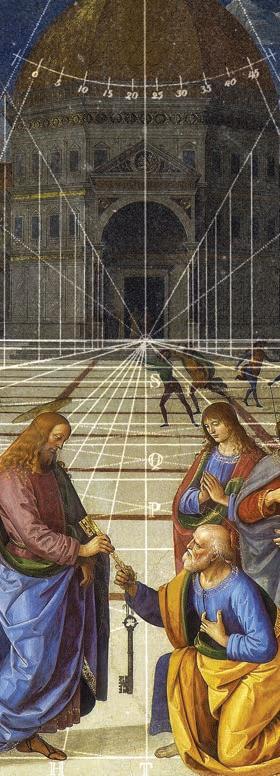
form of adjusting the sizes and profiles of objects so as to make them look close or far away. Young children can create a successful example of perspective in art by drawing a set of similar trees scattered in a loose line. The trees "in the back" (probably around the top of the page) can be made small (foreshortening), while trees in the foreground can be made the tallest and broadest. Once crayons are brought out, outlines of a few hills are added (tiny arcs in the distance for faraway mountains; bigger shapes for the hills that lie nearer), and the sky is colored, the child will have created a reasonable example of perspective in art.
Three-dimensional art, like sculpture, employs similar principles of geometry. Perhaps a useful comparison would be the need for a builder to establish the plumb line in construction, where an absolutely straight vertical line, laid at perfect right angles, guides what the builder will do. A sculptor must work out all proportions before beginning to chisel. He needs to understand his materials, his tools, and the mathematical dimensions that will define the very substance of his work, not to mention the issues of weight and gravitational stresses that a sculpture must endure.
Color in art provides an example of art's scientific basis. Everything from the horticultural and mineralogical components of pigment and ink in medieval times, to the advanced chemistry of today's acrylics, from measured techniques that determine the thickness of the color (called texture), to the optical science that explains our perceptions of color—all of this falls within the umbrella of mathematics or science.
For students who wish to delve into more extreme expressions of mathematics in art, it might be rewarding to explore what artists have done with hyperbolic (hyperdimensional) geometry. This movement began largely with Dutch artist M. C. Escher (1898-1972), whose fantastic engravings were spurred by his friendship with the eminent British and Canadian mathematician and geometer Harold Scott MacDonald Coxeter (1907-2003). Coxeter started life intending to become a composer, and his artistic flair never waned. Escher's work adopted Coxeter's enthusiasm for hyperbolic geometry and Escher's resulting fantastic engravings continue to delight, intrigue, and puzzle us today.
A similar geometric procedure underlies what became one of the most influential new musical styles ever to develop: minimalism. Often based on a simple musical idea, minimalism stretches that idea into longer forms with fascinating mathematical patterns of
repetition and subtle variation. From a theoretical style of music to a broad rhythmic current, minimalism has affected our musical palate in everything from classical compositions to film scores and pop hits.
A great deal of modern art is derided upon first impression, and some of it (particularly in terms of theme and message) deserves that derision. But some art that seems abstract actually does form around geometric models, such as fractals, whose geometric structures repeat on different scales. Thus, whether it is obvious or not, some artists who produce seemingly abstract, undisciplined works are working in terms of complex equations whose properties are repeated in carefully measured patterns.
We can look back to classical Greece for arguably our greatest form of art: architecture. Architecture really is the supreme reflection of mathematics in

art, wherein every aspect of a building depends on a precise understanding and application of mass and void, tensile strength, geometry, algorithms, and a dazzling array of algebraic and scientific equations that determine whether a building stands or not. Computers do a great deal of this work today, but let us not forget that the greatest buildings in our Western tradition—those that still stand and those etched solely in the heritage of our memories— began with a pencil that drew geometrical lines and scratched out mathematical equations.
Undeniably, the nineteenth-century Romantic image of the frenzied or dreamy artist, fueled passionately by emotion, still prevails in the popular admiration. That image is a far cry from the realities an artist handles daily when creating a work of visual art. The romanticized image may be glamorous, but recognizing the artist as handmaiden to mathematics and science comes far closer to the truth.
Classical Core Curriculum supplement (Kindergarten, 1st Grade, or 2nd Grade)









$22.00 ea.
These supplemental guides coordinate with our Classical Core Kindergarten, First Grade, and Second Grade programs. Each guide includes an overview of each read-aloud book, author and illustrator biographies, oral reading questions, and a simple language lesson, as well as resources for the history, culture, and science lessons, biographies of the artists, and poetry lessons. Lessons from Music Enrichment are scheduled here as well.


Classical Core Curriculum supplement
Grades Jr. K-2 | $19.45 ea.
The creative arts are an essential part of primary school education. These activities reinforce number and letter recognition, strengthen fine-motor skills, and foster creativity and confidence. There is a craft project for each read-aloud in Memoria Press' Jr. K-2 curriculum packages, and additional crafts that focus on art concepts. Enjoy each of your creations and the time spent together making them.
Classical Core Curriculum supplement
Grades K-2
$14.65
Music
Enrichment goes into more detail about each song studied in our Enrichment Guides, including a short backstory on each song and its composer, as well as a few interesting facts and discussion questions. Purchase of this book also includes links to playlists so you can listen to good recordings of each piece.

Grades K+
Wall Charts (11" x 8 ½") $17.35 | Flashcards (5 ½" × 4 ¼") $11.50

Be respectful, listen carefully, look for opportunities to include others, chew with your mouth closed—these simple, thoughtful guidelines for good manners are a great aid for your classroom or homeschool. There are 36 manners, one for each week of your school year. Each week, hang up the wall chart as a helpful visual aid and use the short explanations and examples on the flashcards to discuss proper behavior at the dinner table, around the home, and out in public.

Lessons for Social Understanding, Habits, & Manners
 by Cheryl Swope
by Cheryl Swope
Ages 4-13
Guide Books $20.95 ea.
Book One Core Set $59.76
Book One Read-Aloud Set $105.90
Book Two Core Set $23.35
Book Two Read-Aloud Set $106.83
Book Three Core Set $60.26
Book Four Core Set $53.12
Grade K
$16.80
Kindergarten Morning Work is designed to practice quick recall of concepts already taught in the Kindergarten Curriculum. It purposefully does not introduce new concepts, but allows young students to build confidence and gives teachers the opportunity to gauge mastery. Two days a week students will review penmanship, phonics, color words, number awareness, and the manner of the week.

Grade K
$6.85
Fine-motor skills are critical for primary students to master. We have paired this Cut & Paste Book with our kindergarten phonics and reading program so that students can practice their scissors skills, using glue, and tracing letters while working on mastery of beginning phonics sounds. The pages are in the same order that students study the alphabet in First Start Reading, with additional pages for the h-consonant teams of sh, th, ch, and wh as they are introduced.

Recommended for Ages 3-5
My Very First Scissors Book $6.85

My Very Own Scissors Book $6.85
Help your student develop hand strength, fine-motor skills, and independence with one or both of these books.


 by Leigh Lowe
by Leigh Lowe
Recommended for Ages 4-5
$33.60 set (2 books)
Teaches letter recognition, letter formation, and pencil grip. This is a gentle introduction to phonics.

Recommended for Ages 4-5
$16.80
This is the great precursor to Numbers Book Part One. This book introduces each number through 15 and color words with tracing and coloring activities.




Recommended for Ages 4-5
Alphabet $6.85 | Numbers $6.85
Practice number and letter recognition while developing fine-motor and coloring skills.
 by Leigh Lowe
by Leigh Lowe
Recommended for Kindergarten
$33.60 set (2 books)
Continued practice with numbers, counting, and patterns for the kindergarten student who is ready to move beyond simple tracing. This a nice supplement to any kindergarten math program.





(4¼'' x 5½")
$11.55
Deck contains one card for each letter of the alphabet. Each card has the upper- and lowercase letter on one side and a simple illustration on the flip side that allows practice with the beginning letter sound.
(also available in New American Cursive font, p. 79) (11'' x 17'') | $17.35

These visual aids reinforce each letter of the alphabet and numbers zero to nine while young students learn to read and write or practice their penmanship. Each illustration is hand-drawn and matches the drawings on the Alphabet Flashcards




Levels A-C | Grades K-2
Student $17.35-$19.95 ea. Teacher $6.00 ea. Our goal for math in the primary grades is the mastery of basic facts. One of the most effective ways to help students achieve mastery is simply to practice. With daily timed drills, Memoria Math Challenge is designed to give students that necessary math practice and also to help the teacher measure students' immediate recall. We start with addition, subtraction, and number dictation in kindergarten, and ramp up to 200 daily problems by the end of first grade. If students are able to master their math facts in the primary years, they can devote more time to complex math operations in grammar school and upper school. Student Drills are on 3-hole-punched loose-leaf paper to make it easy for you to store and copy if you need additional practice.
Arithmetic Flashcards
Addition & Subtraction,
0 to 18
(6" x 4")
$11.50
Multiplication Flashcards
0 to 12
(6" x 4")
$11.50
Division Flashcards
0 to 12
(6" x 4") $11.50
Rod & Staff Math books teach your student number facts and arithmetic skills to mastery using clear, uncluttered lessons and plenty of drill practice.
Grade 1 Arithmetic (3rd Ed.)


Student Part 1 $7.50 | Student Part 2 $7.50
Practice Sheets $18.50
Teacher Manual $22.95
Speed Drills $5.50
Grade 2 Arithmetic (3rd Ed.)




Student Unit 1 $7.50 | Student Unit 2 $7.50
Student Unit 3 $7.50 | Student Unit 4 $7.50
Practice Sheets 1 $8.50 | Practice Sheets 2 $8.50
Supplemental Pack $1.95 | Teacher Manual, Units 1-2 $13.75
Teacher Manual, Units 3-4 $13.75
Grade 3 Arithmetic
Student Book
(with Supplemental Worksheets) $16.50

Teacher Manual (includes Worksheets Key) $17.50
Blacklines $4.95
Speed Drills $5.50
Grades 7-8
Textbook $25.74
Solutions Manual
$25.55
Quizzes & Tests
$11.50
Quizzes & Tests
Answer Key $6.00
Grade 4 Arithmetic
Student $16.50 | Speed Drill Packet $9.50
Teacher Manual Part 1 $13.25
Teacher Manual Part 2 $13.25
Tests $2.75 | Speed Drills $5.50
Grade 5 Arithmetic
Student $16.50
Teacher Manual Part 1 $13.25
Teacher Manual Part 2 $13.25
Tests $2.75 | Speed Drills $5.50
Grade 6 Mathematics
Student $15.95
Teacher Manual Part 1 $13.25
Teacher Manual Part 2 $13.25
Tests $2.50 | Quizzes and Speed Tests $4.75

Grades 7-12
Complete Set $399 (online course + books for modules A-F)
Year One Set $235 (online course + books for modules A-C)
Year Two Set $235 (online course + books for modules D-F)
VideoText Math uses mastery-review techniques to fully explore the language of mathematics and algebraic relations. Students watch a tenminute video that develops each lesson's concept while they follow along with their Course Notes, and then complete the exercises in the WorkText Progress Tests help gauge student mastery throughout the year, with multiple forms of each quiz and test available if your student needs a little extra practice. The Instructor's Guide provides step-by-step instructions for solving the problems on each test, while the Solutions Manual does the same for the WorkText
Geometry course also available!
by Cheryl Lowe | Grade K
$52.55 set (Books A-D + Teacher Guide)
Student Books (A-D) $7.90 ea.
Teacher Guide for Books A-D $20.95

FSR is a balanced, age-appropriate approach to phonics and reading, with a serious focus on correct pencil grip and letter formation. The program uses the traditional (vowel-consonant) approach to phonics combined with word families. The FSR kindergarten program consists of 4 student books with artist-drawn pictures to color, drawing pages for each letter or phonogram, and over 40 stories. The Teacher Guide leads you through the program and provides helpful assessments and teaching tips.









by Amber Wheat | Grade K | $16.80
Designed to be used in conjunction with First Start Reading to reinforce the phonetic concepts learned each week.
by Amber Wheat | Grade K | $16.30
Provides the extra practice needed to master manuscript printing. Correlates with the letter students are working on in First Start Reading.
1
Grade K | $260.15 set
Everything you need to teach your student to read fl uently, including lesson plans!
Grades K-2 | $19.45
These phonetically arranged word lists require students to rely on their mastery of letter sounds. Coordinates with First Start Reading, or is a good supplement to any phonics program.
Grades K-2 | $8.95 ea.
Reading is a subject that should continue through the summer to avoid regression.
$55.00
Let primary specialist Michelle Tefertiller teach your students how to read! These streaming videos use all the books in the Kindergarten Phonics & Reading Set.
Grades K-1
$7.90-$10.50 ea. These Storybooks feature the same targeted phonetic stories found in First Start Reading, with beautifully illustrated black and white pictures to help students stay engaged as they read.

Student Book E $7.90
Teacher Guide for Book E $11.50
We complete our phonics for reading program at the beginning of first grade with First Start Reading Book E, which includes long vowel teams, sounds of soft c and g, and the three sounds of y

Grades K-2
(4¼'' x 5½")
$27.00
Flashcards for the nearly 200 phonograms used to spell the 44 sounds of the English language.
$27.99


Grades K-2
$67.50 set (18 books) | $3.95 ea.
These summer reading journals are a perfect way to encourage young children to continue working on reading fluency. The font size gets smaller for each journal, and each page is divided in half for drawing and writing small summaries. Kindergarten has the unique goal of reading a book a day for 100 days!
Classic stories from The Jungle Book, The Wind in the Willows, Tom Sawyer, and Doctor Dolittle have been adapted in these early readers so young children can read good stories on their level.
A manual for teachers who want to go deeper into the subject of phonics and reading.
$33.99
An excellent phonics resource for grammar school teachers.
Traditional Spelling I-IV
by Cheryl Lowe | Grades 1-4

$57.66 I & II set ea.
(student, teacher, practice sheets, supplemental workbook, supplemental workbook key)
$40.66 III set
(student, teacher, practice sheets)
$34.96 IV set
(student, teacher)
Student $17.35 ea. | Teacher $19.45 ea.
Practice Sheets (I-III only) $6.00 ea.
Supplemental Workbook (I & II only) $8.95 ea.



Supplemental Workbook Key (I & II only) $8.95 ea.
This comprehensive, phonetic approach to teaching spelling is the culmination of our phonics program. Once students have mastered reading "consonant-vowelconsonant" words with short vowels in kindergarten they are ready to begin a spelling program. Traditional Spelling is the perfect next step toward reading fluency. Traditional Spelling provides students with an extensive mastery-based study of phonics.
Each lesson features writing and oral dictation practice, color-coded phonogram activities, and short stories or riddles on the student's reading level that utilize that week's spelling words.

 by Cheryl Swope
by Cheryl Swope
Some children struggle with math. Proposed solutions abound, such as limiting struggling students' math adventures to cooking, measuring, calculating money, and other "reallife" pursuits. But if we assume such a pragmatic approach, what do our children miss? Is there more to math than "useful" application?
In a classical education we view arithmetic and mathematics as far more than useful arts, though they are useful. Rather, we believe that these arts elevate the mind, enhance perceptions of harmony and order, sharpen the memory, and aid in apprehension of the divinely created universe.
When my son contracted COVID-19 well over a year ago, he did not suffer from the typical respiratory effects; instead, he developed a debilitating encephalopathy. To this day he does not remember anything from Christmas through New Year's Eve of that year. The condition left him unable to respond intelligibly, walk, make decisions, or add, subtract, or manipulate the smallest numbers. Once a joyful student of algebra, Michael could no longer fathom or perform the math sentences 1 + 2 = ___ or 1 – 0 = ___.
His short-term memory evidenced dysfunction as well. At the hospital I repeatedly prompted his language in an effort to restore his cognition. I would ask things like, "Michael, they have Greek yogurt; would you like black cherry or vanilla?" Whereas just weeks earlier he would have said, "Black cherry, hands down!" he stared blankly. Then he managed, "Grape vanilla." Prior to encephalopathy, not only would he have made a clear choice, but he could have detailed the purported benefits of Greek yogurt over other forms of yogurt. We had much work to do.
When Michael was finally home and medically stable, we began in earnest. We worked on language, both receptive (understanding) and expressive (speech). He needed rest periods, but we encouraged him to participate in small decisions.
We began again with arithmetic. With perpetual concern, his twin sister volunteered to serve in the role of tutor and dutifully taught him with addition flashcards. Michelle knew, whether instinctively or from experience, to take things slowly. She did not seek to overwhelm the student, but to teach him. She began with 1 + 1 = 2. She stayed with the lower addition cards for weeks. I could hear progress from across the room, as her constant refrains of "Very good!" and "That's it!" encouraged him to try another.
We wanted our son to regain basic arithmetic, but we wanted more: We wanted him to regain his awe of mathematics, his love of order and harmony on the piano he once played, and his fascination with the wondrous design of the created world. In short, we sought to reintroduce our son to the quadrivium—arithmetic, music, geometry, astronomy—that had pervaded his education from his earliest years into adulthood.
In the initial recovery of classical education that began decades ago, much discussion surrounded the trivium, the three language arts of grammar, logic, and rhetoric. As the movement matured, the quadrivium—the mathematical arts—began to receive due focus. Simply summarized, the four mathematical arts that comprise the quadrivium turn our minds to a harmony and beauty higher than ourselves:
arithmetic – number
music (harmonia) – number in time
geometry – number in space
astronomy (cosmology) – number in space and time
While formal studies of the advanced mathematical arts may occur later for many students, for our purposes with our children we need to know only that all of these are desirable, all of these are important, all of these are related, and all of these can be woven throughout our children's education at all levels. The quadrivium is not merely for those who pursue esoteric university studies in mathematics. Whether for a child with learning disabilities, autism, or acute encephalopathy, little by little, we teach. We do so to the greatest extent possible for each child. If we need to move more slowly, more carefully, or with more demonstrations before requiring practice and mastery, so be it. This is and has always been the art of teaching any child. As Quintilian instructs, "It is for us to ascertain how much the minds of boys can receive at any one time."
Notice how well-balanced the combined liberal arts are for us as human beings. A true liberal arts education encompasses all that is right to contemplate and learn. In a classical education we seek to resist the temptation to reduce education to a means of economic gain. We lead the child not only to the liberal arts but also to the liberal sciences—moral, natural, and theological—that draw us to yet higher pursuits no matt er our callings in life. We seek to assert the child's very humanness at every level he can accomplish. A
classical education is worthy of our full exploration, because of the implications for all of our children and for ourselves as human beings. Together the trivium and quadrivium form the seven liberal arts which, when placed together with the great music, art, literature, languages, and ideas of Western civilization, comprise a classical education. All of this is permeated by Truth, Goodness, and Beauty. And for the Christian classical educator, all of this points us to our Creator.

With this approach and by the mercy of God, my family is thankful to report that we have witnessed a slow, steady, remarkable recovery in Michael. He was deemed by his twin "graduated" from fl ashcards in all operations (addition, subtraction, multiplication, and division). As his mental calculations improved, we began playing nightly and increasingly complex board games, which stymied him initially, but which now he is pleased to win on occasion. Michael has resumed his studies on the piano. He plays scales, enjoys the outdoors, and is learning renditions of classical pieces and hymns. He is once again reading the Holy Scriptures and contemplating higher things.
Reassuringly to me, Michael has also embarked on his own study of geometry. He says he finds the pursuit challenging but also "quite fascinating." Thanks be to God.
Choose from:
New American Cursive 1
New American Cursive 2: Scripture & Famous Quotations
New American Cursive 2: Quotations from Famous Americans
New American Cursive 3: Scripture & Lessons on Manners

New American Cursive 3: Famous Quotes & Lessons on Manners


Grades 1+ | $25.00 ea.
The New American Cursive (NAC) penmanship program is an easy-to-follow resource for learning cursive. Simplified letter forms and clear instructions teach your student to write in a fast, legible script. Developed by Iris Hatfield, an educator with 35 years of experience in the handwriting field, the workbooks improve the process of teaching handwriting and allow students to start at a younger age.
In NAC 1, learn how to form each letter, step by step, with clear starting dots and direction arrows. Correct pencil grip, paper position, and posture are illustrated throughout. Fifteen minutes of workbook practice a day is all it takes! NAC 2 will continue to teach correct letter forms and how to easily connect each letter. Proper size, spacing, and slant are emphasized in 125 instructional exercises. In NAC 3 you will further enhance cursive skills by practicing your best handwriting while learning about manners and correspondence protocol.
• Improved neural connections in the brain
• Increased ability to read cursive
• Increased writing speed
• Improved fine-motor skills
• Improved reading and spelling ability
• Increased self-discipline and eye-hand coordination



• Improved attractiveness, legibility, and fluidity of one's signature
• Increased self-confidence, continuity, and fluidity when communicating with the written word
Grade 5-Adult | $25.00
Whether you are a beginning older student or are fine-tuning your penmanship later in life, these self-guided lessons make learning cursive a pleasure. Practice just 15 minutes a day to get remarkable results.
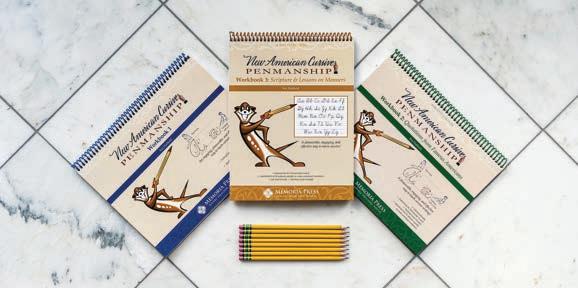
Grades 3+
$13.60
Startwrite CD
$29.95
Create customizable worksheets in the New American Cursive font to integrate handwriting practice with any subject. Digital download also available. (Windows only)
This easy-to-use supplemental resource for mastering a legible, attractive cursive enhances the pleasure of writing by practicing a different, inspiring wisdom Scripture each day. It also includes 50 helpful penmanship tips to improve cursive skills.
Grades K-2
$44.01 set (Copybooks I-III)






$16.30 ea.
Copybooks include memory passages, copybook exercises, and drawing pages, incorporating Scripture from the King James Bible and classic children's poems.
(New American Cursive font)
Grades 1-6 | $16.30 ea. Copybook Cursive I is perfect for second graders alongside NAC 2 or older students needing more practice.
Copybook Cursive II includes Scripture passages from Christian Studies I, the 15 brightest stars from Astronomy, and the major gods from D'Aulaires' Greek Myths. In Copybook Cursive III, students practice their penmanship with beautiful memory passages from Christian Studies II The college-ruled lines of Copybook Cursive IV are perfect for older students honing their penmanship with the Scripture passages from Christian Studies III
Grades K-6
$9.45 ea.
I: 5/8" Ruled for Younger Students
II: 1/2" Ruled for 1st-2nd Grade Students
III: College-Ruled for Older Students
Our Composition & Sketchbooks allow each student to write and illustrate compositions.
Summer Cursive
Grades 1-2
$16.30
This workbook is designed as summer practice for rising second graders who have completed New American Cursive 1. It is arranged in lessons to be completed three times a week during the summer.

Cursive Practice Sheets I-III (New American Cursive font)

Ages 6+
$16.30 ea.
Our Cursive Practice Sheets include pages for practicing each cursive letter, Scripture copywork, and blank practice sheets. Book I is a good companion to NAC 1, Book II is extra practice for NAC 2, and Book III is wide-ruled for any older student who needs more practice.
Alphabet Wall Charts
Available in Manuscript (blue) or Cursive (green)
(11'' x 17'') | $17.35 ea.
These visual aids reinforce each letter of the alphabet while young students learn to read and write or practice their penmanship. Each illustration is hand-drawn. The cursive charts use the New American Cursive font.
(New American Cursive font) by Cheryl

 Swope
Swope
Ages 6-12 (chronological age or skill level) Beginner or Intermediate $9.45 ea. These journals let students practice cursive while thinking about God's daily blessings in their lives. The Intermediate Journal has a smaller font size and less tracing.
Ages 4-11
$10.00
Savor small moments of wonder with your child as he learns the simple beauty of nature. This book can stand alone as a delightful supplement to any program.
by
Cheryl SwopeAges 9+
$21.24 set (Fables and copybook)




Aesop Copybook $10.00

Aesop's Fables $14.99
The Aesop Copybook is a lovely companion to Aesop’s Fables. It will strengthen your student's writing and composition skills while giving the opportunity to contemplate the timeless wisdom of Aesop's fables and learn from the gentle moral instruction they provide.
Manuscript and New American Cursive
(22'' x 34'') | $7.90
This poster lists the entire alphabet in manuscript and cursive. It is the perfect resource if you don't have the space for our Alphabet Wall Charts
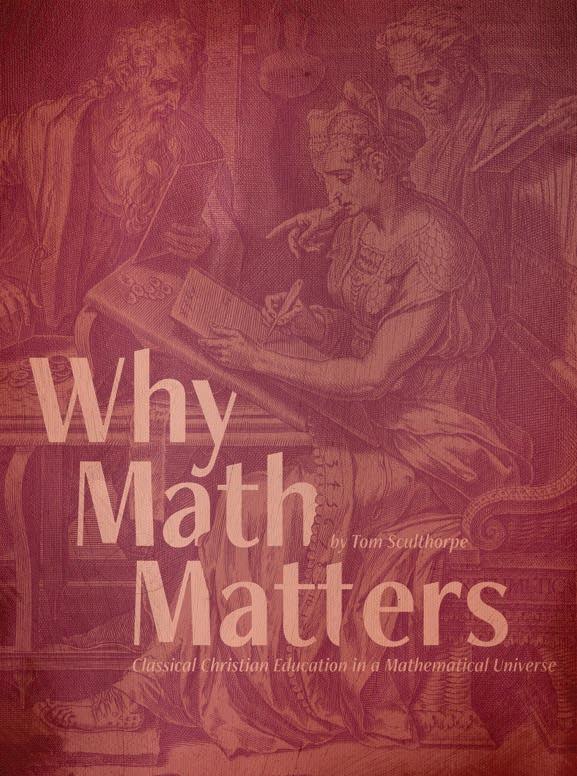
Thanks to a misunderstood statement made by Saint Augustine in De Genesi ad Litteram, which condemned, not mathematics as we define it today, but rather astrology (the popular application of math in his day), many early Christians were strongly opposed to the study of mathematics. But Augustine, in fact, had the highest view of mathematics. For Augustine, nature is inherently quantifiable and mathematical number theory is a creational given. We live in a mathematical universe. Being a former Manichaean and, thus, an expert in Platonic thought, Augustine was no doubt following in the footsteps of Plato, who situated the study of mathematics—the quadrivium of arithmetic, geometry, astronomy (not astrology), and music—as an integral part of what we today call the classical liberal arts. Thus, in Augustine we find, not a condemnation of mathematics, but the essential marriage of classical and Christian thought regarding mathematics. And according to contemporary Christian philosopher James Nickel, "Because man is made in the image of God, he is gifted with the ability to observe the physical Creation and formulate relationships and consequences that both explain and predict." The study of mathematics is precisely this: observation and formulation. To study mathematics, then, is to pursue humanity's divine mandate to order and manage Creation. Studying mathematics as part of a liberal arts education and studying mathematics as a feature of Creation are complementary pursuits, and so mathematics ought to play a vital role in our classical Christian education.
When I ask my students if they like studying mathematics, invariably the class splits evenly. If anything, there are more students who would rather not study math than those who would choose to do so if it were not required. When I ask why, the unanimous response is that math is hard. And the truth is, mathematics is hard. The discipline required to master arithmetic facts and develop a number sense in the lower school years does not relent in the upper school where students must engage in abstract and logical reasoning. And while the difficulty of the subject matter is not what makes mathematics indispensable, a classical education is predicated upon
Tom Sculthorpe serves as the director of math education at Memoria Press and teaches physics and math at Highlands Latin School. He holds a B.S. in physics from the U.S. Naval Academy and an M.Div. from the Southern Baptist Theological Seminary where he is also a Ph.D. candidate in biblical studies. He and his wife, Allison, have five children.
the mastery of difficult content because this requires the very thing that serves as a formal principle of classical education: character. One of the things that makes math indispensable in a classical education is that it contributes to virtue formation. Students who discipline themselves to learn mathematics become virtuous people, people who are able and willing to do hard things even when they may not want to.
Additionally, Morris Kline, mathematician and author of Why Johnny Can't Add, asserts that mathematics has shaped the course of modern history. This is best demonstrated in the impact of the Scientific Revolution and Sir Isaac Newton's development of his calculus, a development which revolutionized science and philosophy along with mathematics, and which married description to causation in a way that had eluded philosophers since Plato and Aristotle. We cannot properly call our education "classical" unless the discipline that shaped the course of history plays an integral role. If mathematics is, as Kline has argued, "a body of knowledge with content that serves scientists, philosophers, logicians, artists, musicians, statesmen, and theologians," then students who will one day become one of these must comprehend mathematics.
Finally, returning to Nickel's assertion that to study mathematics is to, in part, pursue the human vocation, educated people must be able to observe, analyze, and model the universe that the Lord created. A cursory look around us makes plain the reality that not only is this world highly ordered, but also that quantity plays an essential role in everyday life. In fact, quantity is an intrinsic quality which the Lord has woven through Creation. If we are to exercise dominion over this world, we must understand this world. And this world is quantifiable. It is mathematical.
So, what specific mathematical disciplines must we include in a classical education? And what progression through those disciplines makes the most sense? Kindergarten through sixth grade students must study and master arithmetic, the foundation for all further mathematical pursuits. Building on mastery of arithmetic, students must "tame the unknown" through the study of algebra. Moving logically from a premise to a conclusion based on established axioms and properties to determine the value of an unknown quantity—solving a relation—is both a significant logical leap from arithmetic and a necessary step in the
development of critical reasoning skills. Thus, the best progression through algebra for teachers and students alike is a consistent movement from concepts and computation skills that are less complex to those that are more complex, achieving mastery along the way. The development of an efficient, symbolic system of notation and the two-dimensional Cartesian coordinate system by René Descartes in the seventeenth century enabled the conceptual coupling of abstract algebraic reasoning with the concreteness of geometric objects such as points, lines, and planes. Thus, algebra both forms the foundation for further study in higher-order mathematics and serves as a bridge to geometry.
While geometry preceded algebra in historical mathematical development, we reverse the order in our instruction precisely because of Descartes' work. While perennially helpful, the content of Euclid's Elements by itself becomes much more concrete when taught to students who have mastered algebra and analytical geometry. Thus,
One of the hallmarks of classical education, as opposed to more modern pedagogies, is mastery. We do not merely introduce a broad spectrum of topics and concepts in a perfunctory way as if to say, "Look at how much material this course covers!" Rather, we carefully select topics and ensure that students have mastered them—that is, that students have achieved true comprehension or understanding—before moving on to other topics. And mastery in mathematics entails much more than robotically reproducing canned computational methods. A student who has mastered solving first-degree equations in two variables, for instance, can do much more than transform those equations from standard linear form to slope-intercept form or substitute values for one or more variables and evaluate the result. That student can execute those computations easily because he comprehends the relationship between a first-degree equation in two variables and its corresponding graph in the Cartesian coordinate system: a line. He can move seamlessly from the information in slope-intercept form to the same in the graph. He understands what that equation in algebraic notation represents, what the linear graph represents, and how the two are related. That student has mastered algebra.
a substantive study of geometry, including trigonometry, follows algebra to further polish logical reasoning through proofs and to prepare students to model complex real-world realities with calculus. The value and necessity of Descartes' analytical geometry cannot be overstated.
The study of mathematics in the high school years should culminate with calculus. Many will balk at this assertion, but as I argued above, it is impossible to comprehend Western history apart from comprehending calculus. Newton's achievement was the culmination of the thread in Western science and philosophy known as the problem of change raised by Zeno's paradox. While not all students may possess the aptitude to understand complicated calculus computations in the high school years, all can master the concepts of the limit, derivative, and integral along with their historical and philosophical significance. In my humble opinion, no student ignorant of calculus has completed a classical education.
In the interest of computational proficiency, too much of mathematical instruction today has adopted the aim of producing human "calculators." But, to properly orient mathematical study in classical education, we need to complement computational proficiency with conceptual proficiency. The result is an ability to utilize mathematics as a tool to model the Lord's world. While the study of mathematics is a virtuous end, applying it to the physical world acknowledges that as creatures we discover the mathematics the Lord has woven into his Creation—the wisdom of the Lord. When we graduate students who have mastered a robust and integrated mathematical curriculum culminating in Newton's calculus, we are realizing the goal of classical education: the cultivation of wisdom and virtue through meditation on the truth and beauty of the Lord's mathematical universe. Augustine argued that "numbers have fixed laws which were not made by man, but which the acuteness of ingenious men brought to light." May we continue in the tradition of such ingenious men by making mathematics a pillar of our classical Christian education.






Grades 1-2
$35.00
Get to know the heroes of the Bible while working through writing exercises that include key word outlining, paraphrasing, and summarizing stories. Teacher's Manual eBook is included.
Grades 3-4
Student $11.50
Key $11.50


by James A. Selby | Grades 4-12
$96.22 set ea. (student, teacher, videos)
Student $21.95 ea. | Teacher $29.95 ea.
Instructional Videos:
DVDs or Streaming $55.00 ea. (available for I-VIII)
Grades 3-5 | $35.00
Humorous characters and fascinating creatures will help young students enjoy learning to take notes, summarize narrative stories, write from pictures, and compose creative essays. Teacher's Manual eBook is included.
This introductory program focuses on narration, outlining, dictation, and copywork to help students become more proficient in listening and writing skills, a great preparation for Classical Composition . This yearlong writing course uses focus passages from Charlotte's Web , Farmer Boy , A Bear Called Paddington , Mr. Popper's Penguins , and The Moffats
Classical Composition is our study in the progymnasmata ("the before exercises"), a combination writing and pre-rhetoric program that teaches students the fundamental writing skills of style, arrangement, and invention in clear and systematic lessons. The nine stages of Classical Composition will not only teach the art of communication, but are designed to produce what Quintilian once called "the good man, speaking well."
The structured lessons in the Student Guides help students become confident writers as they thoroughly master the incremental skills of each stage. The Teacher Guides provide sample answers for every exercise as well as scripted Chalk Talk. Optional Instructional Videos are also available if you'd like the support of a master teacher to help guide you and your students through the lessons.
Grade 2
Student $8.95 | Teacher $11.50
Designed for the final year of primary school, this program is used as morning work or oral practice of many basic aspects of language arts, from capitalization and punctuation to language and reading skills.

Grades 3-8
English Grammar Recitation $11.50 | Flashcards $14.20


Student $13.60 ea. | Teacher $14.65 ea.
Memoria Press' English Grammar Recitation is perfect for the student who needs an English grammar program that coordinates with his study of Latin. 150 grammar questions with answers and examples, designed to be studied and memorized much like a catechism, are compiled in the English Grammar Recitation reference book. These questions are learned over the course of six years in just thirty minutes a week. Students are given practice exercises in the Student Workbook and the opportunity to practice immediate recall with the Flashcards. The Teacher Guide provides answers to all exercises.












Starting late? No problem! Complete Fable and Narrative in one year and get a reduced package price of $138.98 for both sets of Student and Teacher Guides and videos.
ClassiCal Composition stages:

I: Fable (pictured)
II: Narrative
III: Chreia & Maxim
IV: Refutation & Confirmation
V: Common Topic
VI: Encomium, Invective, & Comparison
VII: Characterization (1 semester)
VIII: Description (1 semester)
IX: Thesis & Law

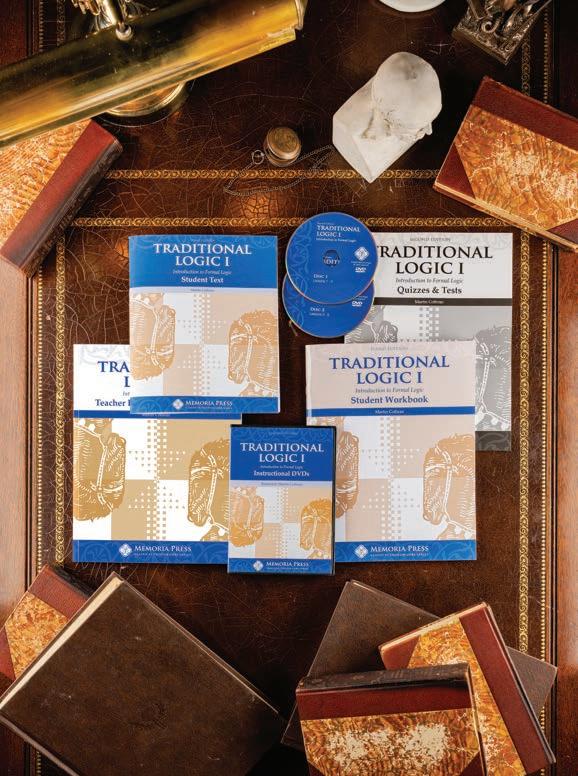








$79.99 complete set ea. (text, workbook, key, quizzes, videos)
$43.74 basic set ea. (text, workbook, key, quizzes)
Text $15.75 ea. | Workbook $18.40 ea. | Key $11.50 ea.
Videos $55.00 ea. | Quizzes $6.00 ea.
 by Martin Cothran | Grades 9+
by Martin Cothran | Grades 9+
$95.99 complete set
(text, workbook, key, quizzes, videos)
$46.49 basic set (text, workbook, key, quizzes)
Text $15.75 | Workbook $18.40
Key $11.50 | Quizzes & Test $6.00
Videos $55.00
Material Logic is a course in how to think. It covers the branch of logic called "informal logic" that deals with the content of argumentation. It can be used as a follow-up to Traditional Logic or simply as an introduction to the rudiments of classical philosophy for high school students. The program covers the ten ways something can exist, the fives ways of saying something about something else, definition, and division.



Traditional Logic I and II cover the branch of logic called "formal logic," which is concerned with the form and structure of reasoning. It focuses on the procedural aspect of reasoning, its mechanics, how we properly get from two premises or assumptions to a conclusion. The program is designed to teach students a practical mastery of the art of argument.
Traditional Logic I presents the four kinds of logical statements, the four ways propositions can be opposed, the three ways which they can be equivalent, and the seven rules for the validity of syllogisms. In Traditional Logic II students will master the use of the nineteen valid categorical argument forms through the memorization of a medieval mnemonic device, and learn the three kinds of hypothetical arguments. Students will study examples of arguments from history and literature.
The Texts explain challenging concepts in clear, concise language. The accompanying Student Workbooks include enough exercises to ensure that the student masters the material before moving on. The Teacher Keys include answers to the workbooks, quizzes, and tests. Instructional Videos are also available if you would like a little help from the author teaching the material.
Classical Rhetoric: Aristotle's Principles of Persuasion
by Martin Cothran | Grades 9+$148.95 complete set
(basic set + How to Read a Book & Figures of Speech)
$97.25 basic set
(student, teacher, videos, Aristotle's Rhetoric)
Student $29.95 | Teacher $11.50
Quizzes & Tests $6.00
Videos $55.00 | Aristotle's Rhetoric $5.00



How to Read a Book $19.99
Figures of Speech $44.95
Classical Rhetoric is a guided tour through the first part of the single greatest book on communication ever written: Aristotle's Rhetoric. This course involves a study of the fundamental principles of political philosophy, ethics, and traditional psychology. Your student will not only learn the basics of political speech, but also the elements of good character, the seven reasons people act, and what elicits specific emotions under particular circumstances and why.
 by Peter Kreeft & Ronald K. Tacelli
by Peter Kreeft & Ronald K. Tacelli
$30.00
(optional supplement)
 by Peter Kreeft
by Peter Kreeft
$22.00
(optional supplement)
(REQUIRED supplement)
$19.99
(optional supplement)
(optional supplement)
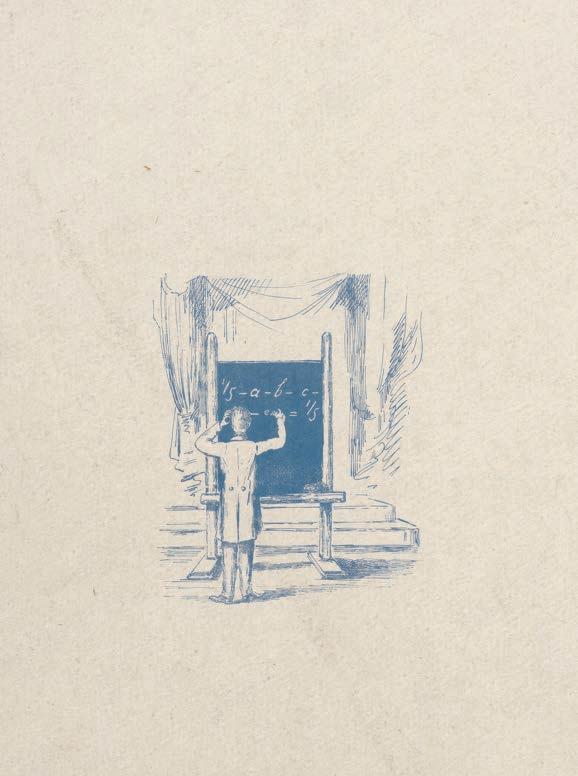 BY BRIAN LOWE
BY BRIAN LOWE
We are not a STEM school because we don't treat science, technology, engineering, and mathematics equally—or even close to equally. It would be more accurate to say we are a math and science school, in that order. Our goal is not to graduate trained engineers, programmers, or technologists. Our job, as a K-12 school, is to graduate students who are prepared to pursue any field successfully. While robotics and advanced experiments look great on social media, we must be humble enough to recognize our place in your child's education. Our job in math and science is one of restraint—we must focus on the basics, not pursue flashy new things. In addition to being great writers and readers, our students must graduate with proficiency in the fundamental math and science necessary to be successful in any science or engineering field.
It is a common theme of progressive education to replace the fundamental skills that should be taught in K-12 with higher-level skills that sound impressive but that students are not ready for. In sports, it is equivalent to a youth league looking at the NBA and deciding to teach dunking and three-point shooting instead of dribbling and layups.
This idea of skipping the basics and jumping straight to advanced skills started on the language side of education and then made the jump to the sciences with STEM. It originally started with reading in primary school. Forty years ago, schools decided that what students needed to know was how to read, and that they were wasting time on rote phonics. So progressive educators decided to drop phonics and to teach reading by simply giving students books and letting them start reading. Teachers were skipping the foundational skill of phonics and trying to jump right to the advanced skill of reading. This "whole language" or "balanced reading" program proved a disaster, and nearly every state in the U.S. has abandoned it (except Kentucky and one other state). They have gone back to phonics because it is proven to work—though they now call it the "science of reading." I think progressive educators
were only convinced to go back to phonics because it was given a new name.

The next trend popped up in middle and high schools in the late 1990s and early 2000s. Schools had traditionally always focused on reading and writing, but in the real world, we were told, people actually needed to know how to collaborate on team projects and presentations. The focus of K-12 became projects and teamwork, not simple reading and writing. Poster boards, PowerPoints, and tri-fold project boards replaced books and papers. These timewasting group projects only started to fade when STEM caught the attention of educators.
Today, it is STEM that has taken up the progressive mantle. Instead of teaching mathematics, biology, chemistry, and physics, we are supposed to teach robotics, app programming, and artificial intelligence. We are to glide over the fundamental sciences and mathematics and jump ahead to the final product of technology and engineering.
At Highlands Latin School and Memoria Press, we don't do this. We never dropped phonics. You will hopefully never need a tri-fold project board. And we teach our students the skills of observation and classification in the lower school and biology, chemistry, and physics in the upper school. But far more than these sciences, we teach mathematics, the language of all science. We focus on math because math is the subject that most limits students in their science education. If you can't do algebra you can't be a chemist, and if you can't do calculus you can't be a physicist. Math is the language used to describe the logic behind the physical world.
So, what is our approach to math? I once heard IEW's Andrew Pudewa give a terrific speech about the value of memory and memorization. In his talk he said that you can't expect something out of a mind that isn't already in that mind. You wouldn't expect Chinese from a mind that doesn't know Chinese. You wouldn't expect Latin from a mind that doesn't know Latin. And you wouldn't expect great writing from a mind that doesn't know English vocabulary and grammar and syntax.
The same is true for math. Mathematics is a language with vocabulary, grammar, and expression. Arithmetic is the vocabulary: It contains the building blocks for all mathematics. Algebra is the grammar of mathematics, where students begin to put simple sentences together. Calculus, proofs, and other advanced mathematics are the expressions of math—these are the beautiful novels and poems of the language of mathematics where we start to precisely represent the world around us.
When we understand that mathematics is just another foreign language, we immediately know what to do with the vocabulary, in this case arithmetic. We memorize it—to mastery. Just as having to constantly look up vocabulary in Latin will eventually be the end of any Latin student, having to constantly calculate simple arithmetic will be the end of any math student. When you don't know the vocabulary you can't translate, and you certainly can't write. In math, when you don't know arithmetic you can't do algebra, and you certainly can't do calculus.
This is why our focus in kindergarten through sixth grade is mastery of math facts. We demonstrate and practice mastery through daily timed speed drills. Our students will work twenty to forty thousand arithmetic problems each school year in their speed drills. We make it really hard for students not to master their math facts.
The reason we want them to be able to compute arithmetic instantly, without thought, is because each algebra problem will have five or ten arithmetic problems embedded in it. If students must stop and think about the arithmetic each time, they will be too slow or make too many errors to solve their algebra correctly. Anyone who has taught algebra will tell you that the first year of algebra is really just easy algebra with hard arithmetic, and that students almost always make their mistakes in the arithmetic.
Does this approach to math and science work compared to a technology- and engineering-oriented STEM focus? It is one thing to talk about our theory of education and another to get results.
At Highlands Latin this year, our senior class had an average SAT reading/writing score of 721, one of the highest in Louisville. People somewhat expect that from our students because we are known as a language school. But our SAT math average is 717. This is also one of the highest in the city, and over the last ten years our math scores have consistently averaged the highest in the city.
More than fifty percent of our graduates go into science, math, and engineering fields in college. That is compared to the national average of eighteen percent. Our high percentage is partially because our students are all capable of pursuing any major, but I think part of it is because they have a balanced education and are not burned out on STEM when they leave Highlands. (It could also be because they are running away from Latin!)
I'll conclude with one of the best arguments for a mastery approach to mathematics, a quote popularized by Mark Twain: "There are three types of lies: lies, d—ed lies, and statistics." If our students don't know math, we must be prepared for them to be deceived by those who do.

Grades 3+ $72.67 set (student, teacher,
Student $16.75
Teacher $18.85
The World of Mammals $21.00




What Is a Mammal? $9.95
What Is the Animal Kingdom? $9.95
The young student's natural fascination with animals makes this in-depth study of the habitats, behaviors, and classification of mammals a wonderful grammar school course. Lessons draw from The World of Mammals, What Is the Animal Kingdom?, and What Is a Mammal? and include comprehension questions, drawing exercises, and observation pages.

Grades 3+
Student $16.75 | Teacher $19.90
Teach your student the story of the sky! This guide covers stars, constellations, the solar system, and the zodiac.

Grades 4+
$69.44 set (text, student, teacher, field guide, flashcards)
Text $17.35 | Student $17.35
Teacher $19.45 | eBook $12.00
Flashcards $14.00 | Peterson Guide $8.99
A narrative approach to the life of insects that takes your student through classification, anatomy, and more!


$82.16 set (text, student, teacher, field guide, coloring book, flashcards)
Text $20.50 | Student $17.35 | Teacher $19.45
Peterson Guide $8.99 | Coloring Book $10.99 | Flashcards $14.00
The Book of Birds is a thorough introduction to a fascinating avian world, covering everything from anatomy and the physics of flight to social habits and habitats.

by Sean Brooks | Grades 6+
$67.23 set (text, student, teacher, field guide, Tree Book)


Text $17.35 | Student $17.35 | Teacher $19.45
Peterson Guide $8.99
The Tree Book for Kids and Their Grown-Ups $15.95
Do you know that the very gift of breath is the result of the oxygen that trees and plants produce? Or that trees and plants provide the means of sustenance for all life on Earth? The Book of Trees , along with the Student Workbook and Teacher Guide , will teach your student both plant morphology and taxonomy (the different parts and different kinds of plants), as well as photosynthesis and respiration. Other chapters cover flowers and fruits. The second half of the course is dedicated to tree observation and classification.



Grades 5-9
Text $14.99 ea.
Supplemental Student Questions $6.00 ea.
Teacher Key & Tests $8.95 ea.
J. H. Tiner's illustrated science books for middle school students are written from a biblical perspective and have won numerous awards. Each includes review questions and activities for every chapter, and Memoria Press has written supplemental questions, unit reviews, and tests for each book.



Choose From:
Exploring the History of Medicine

Exploring Planet Earth
Exploring the World of Mathematics

Exploring the World of Chemistry
 by Christopher O. Blum & John A. Cuddeback
by Christopher O. Blum & John A. Cuddeback
Grades 6+
Text $21.95 | Student $13.60
Teacher $14.65
Exploring the World of Physics
Exploring the World of Biology
Exploring the World of Astronomy


Grades 6+
See full book and price lists on MemoriaPress.com!
Novare is committed to a mastery-learning paradigm. Accurate explanations and a thorough treatment of the subject matter characterize these courses from start to finish. The Digital Resources download includes quizzes and exams, a teacher key, weekly review guides, and more.
Choose From:
Physical Science
Earth Science
Introductory Physics
General Chemistry
Accelerated Chemistry
Physics: Modeling Nature
General Biology
This introduction to natural history instills in the beginning student of biology a love for the beauty and order of the animal kingdom through the eyes of the classical naturalists. Students will be led from the invertebrate animals through the five great vertebrate classes to the culmination of the natural order, a consideration of man as the knowing animal and as a steward of Creation.


